Tabletkiosk A7300TK71 7” UMPC User Manual TK a7330 Users Guide Eng01 0827
Tabletkiosk 7” UMPC TK a7330 Users Guide Eng01 0827
Users Manual
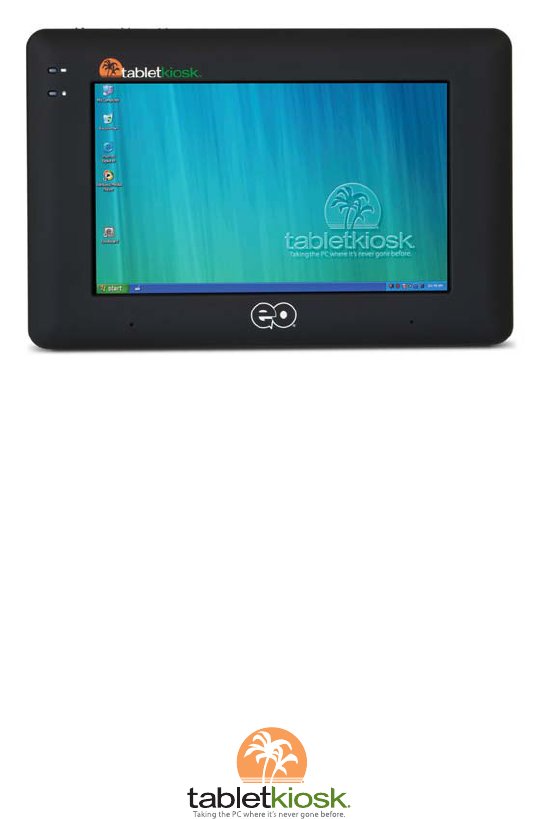
User’s Guide
eo™ a7330
7¨ UMPC

Preface i
This manual will help you get the most out of your new
eo™ Ultra-Mobile PC. If you are a new computer user, or just new
to Tablet PCs, read through this manual carefully before first
using your eo Ultra-Mobile PC. If after reading this manual you
still have questions, visit us online at www.tabletkiosk.com for
additional resources and information on using your eo a7330
Ultra-Mobile PC.
Copyright
©2009 Sand Dune Ventures, Inc. All Rights Reserved. All product
information is subject to change without notice. eo, the eo logo,
TabletKiosk and the TabletKiosk logo are registered trademarks
or trademarks of Sand Dune Ventures, Inc. in the United States
and/or other countries. Microsoft Windows, Windows XP,
Windows Vista, and the Windows logo are either registered
trademarks or trademarks of Microsoft Corporation in the United
States and/or other countries. Intel, the Intel logo, Intel Atom,
and Atom inside are trademarks of Intel Corporation in the U.S.
and other countries. The Bluetooth® word mark and logos are
owned by the Bluetooth SIG, Inc. and any use of such marks by
TabletKiosk is under license. openSUSE and SUSE are trademarks
of Novell, Inc. in the United States and other countries. Linux is a
registered trademark of Linus Torvalds.
Preface
Preface

ii Preface
Disclaimer
The specifications and information in this manual are subject
to change without prior notice in order to improve reliability,
design and/or function. In no way does this represent a com-
mitment on the part of the manufacturer. The manufacturer
assumes no responsibility for errors or omissions in this document.
In no event will the manufacturer be liable for direct, indirect,
special, incidental, or consequential damages arising from the
use, or inability to use, the Ultra-Mobile PC or this documenta-
tion, even if advised of the possibility of such damages.
This document contains proprietary information protected
by copyright laws. All rights are reserved. No part of this
manual may be reproduced by any mechanical, electronic, or
other means in any form without prior written permission of
TabletKiosk.
If you have any questions regarding the eo Ultra-Mobile PC, or
the information contained within this manual, please contact
TabletKiosk at info@tabletkiosk.com.
Important Safety Instructions
For your own safety and the safety of your equipment, please
follow these rules for the handling and care of your eo Ultra-
Mobile PC. Keep this User’s Manual for future reference by you
and other users.
Never use sprays, liquids or cleaning detergents to clean the
eo Ultra-Mobile PC. Use a micro fiber cloth to clean the touch
screen. Avoid the use of tissue paper since tissue fibers can easily
lodge between the touch screen and the top cover of the tablet.
Never pour liquids into any opening or directly on the eo Ultra-
Mobile PC. This could result in fire or electrical shock.
Check that the voltage range of the power outlet is between
100V and 240V before connecting the eo Ultra-Mobile PC.
Preface iii
Exceeding the maximum rated voltage may cause damage to
the AC adapter or to the eo Ultra-Mobile PC. This could result in
fire or electrical shock.
When the AC adapter is plugged into an electrical outlet, place
the power cord so it will not be stepped on or walked on. Do not
place objects over or on the power cord.
Use the eo Ultra-Mobile PC in a clean, dry, temperature con-
trolled environment. Do not use the eo Ultra-Mobile PC in areas
of high humidity, around water (for example: near a bathtub,
washbowl, kitchen sink or laundry tub, in a wet basement or near
a swimming pool) or outdoors while it is raining.
Never open or disassemble the eo Ultra-Mobile PC. For safety
reasons, and to prevent permanent damage, the equipment
should only be repaired by qualified service personnel.
Contact a qualified service center if any of the following issues
should arise:
1. AC adapter, power cord or plug is damaged;
2. Liquid has been spilled into the eo Ultra-Mobile PC;
3. The eo Ultra-Mobile PC has been exposed to excessive
moisture;
4. The eo Ultra-Mobile PC exhibits errors and/or does not
function according to specifications;
5. The eo Ultra-Mobile PC has been dropped or otherwise
physically damaged.
Caution
Lithium-Ion batteries can be dangerous. There is a danger of
explosion if the battery is incorrectly replaced. Replace only with
the same or equivalent type recommended by the manufacturer.
Dispose of used batteries according to state or local hazardous
waste requirements.

iv Preface
Under no circumstances should the user attempt to disassemble
the power supply. The power supply has no user-replaceable
parts and its insides contain components that are electrically-
charged with hazardous voltage levels that can cause serious
personal injury. A defective power supply must be returned to
your dealer.
Safety Notices for the Power Cord
This equipment has a 2 or 3-wire power cord. Replace the power
cord if it becomes damaged. Contact your dealer for an exact
replacement.
In the U.S.A. and Canada, the power cord must be a UL-listed
detachable power cord (in Canada, CSA-certified).
2-wire cord SPT-2 18AWG
3-wire cord SVT or SJT, 18 AWG, 3-conductor
The cord should be provided with a molded-on cord connec-
tor body at the other end. The cord length must not exceed 3
meters (9.8 feet).
Outside the U.S.A. and Canada, the plug must be rated for
250 VAC, 2.5 amp minimum, and must display an international
agency approval marking. The cord must be suitable for use in
the end-user’s country. Consult your dealer or the local electrical
authorities if you are unsure of the type of power cord to use in
your country. Voltage changes occur automatically in the power
supply.
Notice of FCC Compliance
a. Federal Communications Commission (FCC) Requirements,
Part 15:
This device complies with Part 15 of the FCC rules.
Operation is subject to the following two conditions:
Preface v
1. this device may not cause harmful interference,and
2. this device must accept any interference
received,including interference that may cause undesired
operation.
This equipment has been tested and found to comply with
the limits for a Class B digital device, pursuant to Part 15 of the
FCC Rules. These limits are designed to provide reasonable
protection against harmful interference in a residential instal-
lation. This equipment generates, uses, and can radiate radio
frequency energy and if not installed and used in accordance
with the instruction manual may cause harmful interference
to radio communications. However, there is no guarantee
that interference will not occur in a particular installation. If
this equipment does cause harmful interference to radio or
television reception, which can be determined by turning the
equipment off and on, the user is encouraged to try to correct
the interference by one or more of the following measures:
Reorient or relocate the receiving antenna.
Increase the separation between the equipment and the
receiver.
Connect the equipment into an outlet on a circuit different
from that to which the receiver is connected.
Consult the dealer or an experienced technician for help.
Use only shielded I/O cables to connect I/O devices to this
equipment.
You are cautioned that any changes or modifications not
expressly approved by TabletKiosk could void your authority
to use the equipment.
b. Regulatory information / Disclaimers
This device must be installed and used in strict accordance
with the instructions included in the user documentation
provided with the product. Any changes or modifications
(including the antennas) made to this device that are not
vi Preface
expressly approved by the manufacturer may void the user’s
authority to operate the equipment. The manufacturer is not
responsible for any radio or television interference caused by
unauthorized modification of this device, or the substitution
of the connecting cables and equipment other than the ones
specified by manufacturer. It is the responsibility of the user to
correct any interference caused by such unauthorized modifi-
cation, substitution or attachment. The manufacturer and its
authorized resellers or distributors will assume no liability for
any damage or violation of government regulations arising
from the failure to comply with these guidelines.
c. For portable devices without a co-location condition (eg.
notebook pc)
FCC RF Radiation Exposure Statement:
1. This Transmitter must not be co-located or operating in
conjunction with any other antenna or transmitter.
2. This equipment complies with FCC RF radiation exposure
limits set forth for an uncontrolled environment. This
device was tested for typical lap-held operations with the
device contacted directly to the human body to the back
side of the Tablet PC. To maintain compliance with FCC RF
exposure compliance requirements, please follow opera-
tion instruction as documented in this manual.
The availability of some specific channels and/or operational
frequency bands are country dependent and are firmware
programmed at the factory to match the intended destination.
The firmware setting is not accessible by the end user.
d. SAR Exposure
This device has been tested for compliance with FCC RF
Exposure (SAR) limits in typical flat configurations.
In order to comply with SAR limits established in the ANSI
C95.1 standards, it is recommended that the integrated
antenna is positioned more than 1.5cm from your body or
Preface vii
from nearby persons during extended periods of operation. If
the antenna is positioned less than 1.5 cm (0.6 inches) from the
user, it is recommended that the user limit the exposure time.
FCC Statement to Users for the Fax/Modem
Notice of FCC Compliance for the Fax/Modem
This equipment complies with Part 68 of the FCC rules. The FCC
Registration Number and Ringer Equivalence Number for this
equipment are located on a label at the bottom of this equip-
ment. IF REQUESTED, THIS INFORMATION MUST BE GIVEN TO
THE TELEPHONE COMPANY.
The REN helps to determine the number of devices you may con-
nect to your telephone line while allowing all of those devices to
ring when your telephone number is called. In most, but not all
areas, the amount of devices connected to one line should not
exceed five (5).
To know precisely how many devices you may connect to your
line, as determined by the REN, you should contact your local
telephone company to determine the maximum REN for your
calling area.
If your telephone equipment causes harm to the telephone
network, the telephone company may disconnect your service
temporarily. They may notify you in advance, but if advance
notice is not practical, you will be informed of your right to file a
complaint with the FCC.
Your telephone company may make changes in its facilities,
equipment, operations or procedures that could affect the
proper functioning of your equipment. If they do, you will be
notified in advance and given the opportunity to maintain
uninterrupted telephone service.
The telephone company may ask you to disconnect this equip-
ment from the network until the problem has been corrected
or until you are sure that the equipment is not malfunctioning.
viii Preface
This equipment may not be used on coin service provided by the
telephone company.
The Telephone Consumer Protection Act of 1991 makes it unlaw-
ful for any person to use a computer or an electronic device to
send any message via a telephone facsimile machine unless such
message clearly contains in a margin at the top or bottom of
each transmitted page or on the first page of the transmission
the following information:
The date and time of transmission
Identification of either business, business entity or individual
sending the message;
Telephone number of either the sending machine, business
entity or individual.
In order to program this information into your fax/modem,
please refer to the appropriate instructions in your fax/modem
manual.
Note-TNV Safety Caution:
To reduce the risk of fire, use only No. 26 AWG or larger UL
Listed or CSA Certified Telecommunication line cord. Avoid
using a telephone (other than a cordless type) during an
electrical storm. There may be a remote risk of electric shock
from lightning. Do not use the telephone to report a gas leak
in the vicinity of the leak.
Canadian EMI Compliance Statement
This Class B digital apparatus meets all requirements of the
Canadian Interference - Causing Equipment Regulations.
IC Warning statement:
a. WLAN
“To prevent radio interference to the licensed service, this
device is intended to be operated indoors and away from
Preface ix
windows to provide maximum shielding. Equipment (or
its transmit antenna) that is installed outdoors is subject to
licensing.”
b. For LPD
“Operation is subject to the following two conditions: (1) this
device may not cause interference, and (2) this device must
accept any interference, including interference that may cause
undesired operation of the device.”
This Class B digital apparatus complies with Canada RSS-210.
The abbreviation, IC, before the registration number signifies
that registration was performed based on a Declaration of
Conformity (DoC) indicating that Industry Canada technical
specifications were met. It does not imply that Industry Canada
approved the equipment.
European Union CE Marking Declaration
This product has been tested and found to comply with the EMC
requirement subject to the EU directive for CE marking.


Table of Contents xi
Preface i
Copyright i
Disclaimer ii
Important Safety Instructions ii
Notices of Regulatory Compliance iv
Getting Started 1
What’s in the Box 1
Setting Up Your eo Ultra-Mobile PC 2
Step 1: Inserting the Battery Pack(s) 2
Inserting the Main Lithium-Ion Battery Pack 2
To Remove the Main Lithium-Ion Battery Pack 3
Inserting the Secondary Lithium-Polymer Battery Pack 3
To Remove the Secondary Lithium-Polymer Battery Pack 4
Step 2: Connecting the Ultra-Mobile PC to an External Power Source 4
Step 3: Connecting Applicable Peripherals and Networking Cables 5
Step 4: Powering on the eo Ultra-Mobile PC 5
Step 5: Completing the Operating System Installation 6
Interacting with the Active Digitizer and/or Touch Screen 6
Touch Screen mode 6
Active Digitizer mode (a7330D only) 7
Touring Your eo Ultra-Mobile PC 9
Front View 10
Top View 12
Left Side View 14
Right Side View 15
Back View 16
Bottom View 17
Battery Usage and Care 19
Using the Battery for the First Time 19
Charging the Battery Under Typical Conditions 20
Problems Charging the Battery 21
Battery Status 21
Low Battery Warnings 21
About Battery Pack Usage 22
Real Time Clock Battery 22
Storing a Battery 23
Table of Contents
xii Table of Contents
Using Your eo a7330 with Windows 25
Navigating with the Stylus Pen 25
Touch Screen Settings and Calibration 26
Right-Click Emulation 26
Touch Screen Behavior 27
Enable Touch 27
Hide Cursor 27
Touch Sound 27
Calibrating the Touch Screen 28
Digitizer Settings and Calibration (a7330D only) 28
Pen Tab 29
Pen Button Action 29
Pen Tip Options 29
Enable Eraser 29
Click Sound 30
Advanced Settings 30
Pop-Up Menu Tab 30
Calibrate Tab 31
Windows Tablet and Pen Settings Control Panel 32
Programming the Function Buttons 33
Opening an Application, Document or Web Page 34
Assigning a Pre-Defined Function 34
Setting the Screen Brightness 35
Changing Screen Resolution, Color and Rotation 35
Display Settings 35
Display Expansion 35
Color Correction 36
Entering Text with the Input Panels 37
Writing Pad 37
Character Pad 38
On-Screen Keyboard 38
Entering Text with the Eyesboard™ Virtual Keyboard 39
Installing the Eyesboard Keyboard (Tablet PC Edition only) 39
Accessing the Eyesboard Keyboard 39
Connecting to the Internet 40
Using a Wireless LAN 40
Using a Wired LAN 42
Using Both DHCP and a Static IP Address 43
Bluetooth® Wireless Connectivity 44
Bluetooth Device Registration and Pairing 44
Table of Contents xiii
Securing Your eo a7330 49
BIOS Settings 49
Creating a Windows Login Password 50
Creating the Password In Windows XP 51
Creating the Password In Windows Vista 51
Setting Ownership of the TPM 52
Windows XP Professional 53
Windows Vista 53
Troubleshooting 57
Recovering Your System Using the System Restore DVD 63
What you will need before you begin 63
Recovering with the Windows Vista® Business System Restore Disc 63
Recovering with the Windows® XP System Restore Disc 65
What to do After You Have Restored Your System 66
Specifications 69
Processor 69
Chipset 69
Power Management 70
Memory 70
Battery 70
Hard Drive 70
Video 71
Display 71
Audio 71
WiFi Wireless 72
Bluetooth® Wireless 73
GPS Module 73
Gigabit Ethernet Embedded LAN Controller 74
TPM Security 74
I/O Ports 74
Weight 75
Measurements 75
Case Color 75
LED Indicators 75
Function Buttons (Right Side) 75
Control Switches (Top) 76
AC Adapter 76
Operating Environment 76
Storage Environment 76


Chapter 01: Getting Started 1
Chapter 01
Getting Started
Your eo a7330 Ultra-Mobile PC was designed to allow you to
be up and running as quickly as possible. Because the eo a7330
ships to various countries around the world, set-up may vary
slightly depending on where you are located.
If you have any questions after reading this manual, please visit
our website at www.tabletkiosk.com for more information or to
submit a support request.
What’s in the Box
Your eo a73301 should come securely packaged in its shipping
carton along with the items listed below2. Please contact your
dealer immediately if anything is missing or damaged.
1. Power Cord and AC Adapter
2. Microfiber Cleaning Cloth
3. Neoprene Slip Case
4. Quick Start Guide
5. Operating System Getting Started Guide3
1 There are two models of the eo a7330 Ultra-Mobile PC: the a7330D and a7330T.
Please check to make sure that you have received the correct model.
2 Contents of the packaging may change without prior notice. Please check our
website at www.tabletkiosk.com,or check with your dealer or sales associate
for the most up-to-date list if your package contents vary.
3 Please be sure to check that the Getting Started Guide matches the Operating
System (OS) preloaded on your eo a7330. There will not be a Getting Started
Guide included if you ordered your Tablet PC with openSUSE Linux.

2 Chapter 01: Getting Started
6. System Restore Disc1
7. Standard a7330 Battery Pack(s)2
Setting Up Your eo Ultra-Mobile PC
Please read the following steps to begin using your new Ultra-
Mobile PC as quickly and easily as possible.
1. Inserting the Battery Pack(s) if your Ultra-Mobile PC shipped
from the dealer without pre-inserted batteries.
2. Connecting the eo Ultra-Mobile PC to an external power
source.
3. Connecting applicable peripherals and networking cables.
4. Powering on the eo Ultra-Mobile PC
5. Completing the Operating System Installation
Step 1: Inserting the Battery Pack(s)
Turn the eo Ultra-Mobile PC over and place it, screen down on a
solid, clean, flat surface.
CAUTION: When turning over the eo Ultra-Mobile PC, be careful not to
place it on a surface that could scratch or damage the screen. You can
place the included slip case on the surface before carefully setting the
computer down to protect the screen.
Inserting the Main Lithium-Ion Battery Pack
Align the battery so that the power output port on the bottom
of the battery matches up with the power input pins on the back
of the a7330. Angle the battery slightly down and place it in the
battery slot so that the battery’s small retaining tabs fit into the
1 Please be sure to check that the System Restore Disc matches the Operating
System (OS) installed on your eo a7330. There will not be a System Restore
Disc included if you ordered your Ultra-Mobile PC without an OS option. Some
units may include a restore image on the internal hard drive in addition to, or
in lieu of, a restore disc.
2 The eo a7330D comes standard with a Lithium-Ion main battery pack and
Lithium-Polymer secondary battery pack. The eo a7330T comes standard with
only the Lithium-Ion main battery pack.
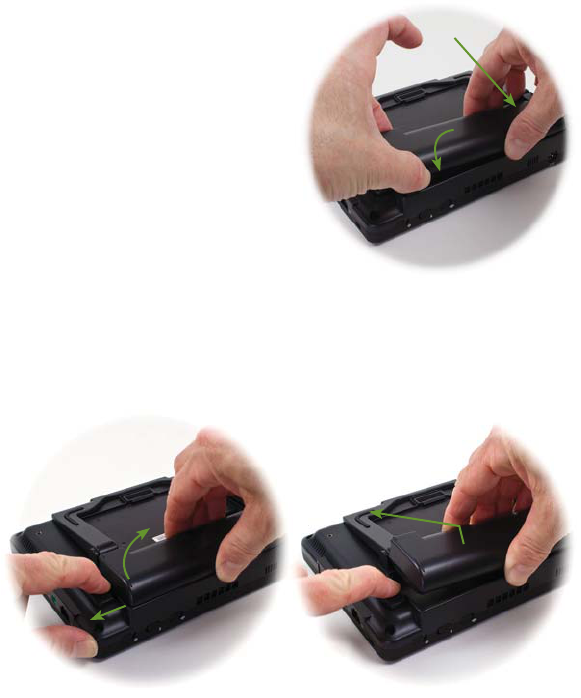
Chapter 01: Getting Started 3
matching grooves on the eo just beside the power input
pins. Then lay down the
opposite side of the battery
into the slot until it “clicks”
into place.
To Remove the Main Lithium-Ion
Battery Pack
Turn over the tablet and place
it on a solid, clean flat surface.
Slide the battery release latch
away from the battery and hold it there. Use your other hand
to carefully lift up the side of the battery near the latch. Once
clear of the latch, you can release it and use both hands to lift
the battery up and away from the opposite side that holds the
retaining tabs into place.
Inserting the Secondary Lithium-Polymer Battery Pack
Align the battery so that the power output port on the bottom
of the battery matches up with the power input pins on the back
of the a7330. Angle the battery slightly down and place it in the
battery slot so that the battery’s small retaining tabs fit into the
matching grooves on the eo just above the power input pins.
Then lay down the opposite side of the battery into the slot until
it “clicks” into place.
!
@
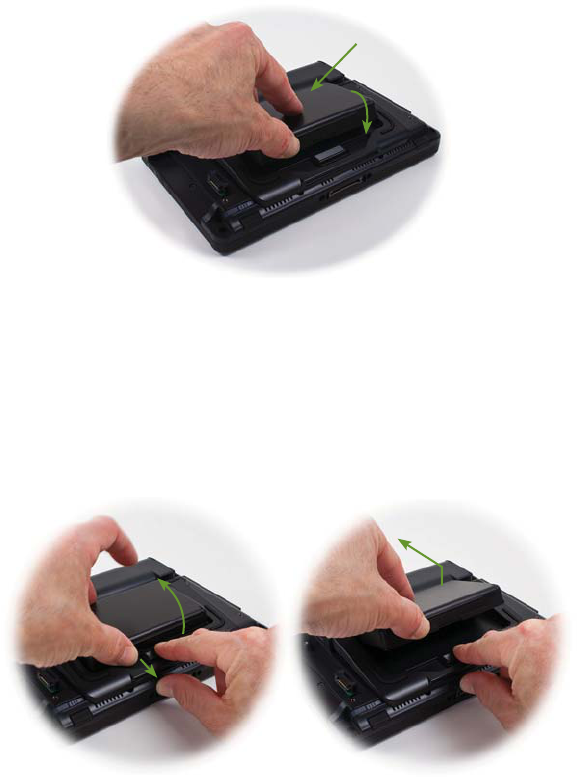
4 Chapter 01: Getting Started
To Remove the Secondary Lithium-Polymer Battery Pack
Turn over the tablet and place it on a solid, clean flat surface.
Slide the battery release latch away from the battery and hold
it there. Use your other hand to carefully lift up the side of the
battery near the latch. Once clear of the latch, you can release
it and use both hands to lift the battery up and away from the
opposite side that holds the retaining tabs into place.
Step 2: Connecting the Ultra-Mobile PC to an External Power
Source
Locate the AC adapter and the power cord. Plug the power cord
securely into the AC adapter. Plug the AC adapter’s connection
cable into the “DC Power In” port on the top of the tablet. Once
!
@
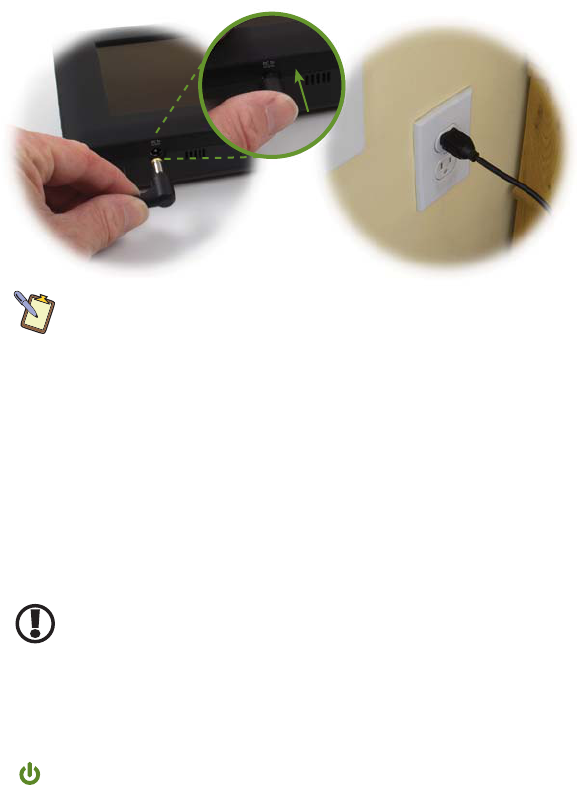
Chapter 01: Getting Started 5
the adapter plug is securely in place, plug the power cord into an
external power socket.
NOTE: When you first connect the tablet into an external power
source, the battery charge indicator will begin to glow amber. When
the battery is fully charged the indicator will turn green. See the
section entitled Battery Care for tips on maximizing battery life and
performance.
Step 3: Connecting Applicable Peripherals and Networking Cables
If you would like to use any external peripheral with the tablet
(i.e. USB mouse, USB keyboard, etc.) or are planning to connect
to the Internet and/or a corporate LAN using a wired connection
(RJ45) as opposed to wirelessly, connect the external peripheral
now. See the chapter entitled Touring Your eo Ultra-Mobile PC, to
identify which ports to use.
IMPORTANT: When you power on the a7330T for the first time, you
will need to have an external USB keyboard connected in order to
complete the Windows XP Professional installation routine. The
a7330D can use the on-screen keyboard in Active Digitizer mode.
Step 4: Powering on the eo Ultra-Mobile PC
Locate the three power switches on the top on the tablet. The
switch is the computer’s main power toggle. Slide it to the
right and hold it there until it emits a blue glow (about 1-2
seconds) and then release it. The eo Ultra-Mobile PC will now
boot up.

6 Chapter 01: Getting Started
Step 5: Completing the Operating System Installation
When your system powers on for the first time, Windows will
have a few questions for you to answer in order to localize your
installation.
NOTE: You’ll need a USB keyboard connected to your a7330T in order
to answer some of the questions that require text input. You can use
the on-screen keyboard with your a7330D in Active Digitizer mode.
Refer to your operating system’s manual for information on any
of the questions you are unsure how to answer.
Interacting with the Active Digitizer and/or Touch Screen
Unlike a standard laptop or desktop PC, standard navigational
activities on an Ultra-Mobile PC are completed using the stylus
pen, or even your fingers if using the touch screen. The screen
will react to the pen differently depending on whether you are
using the Touch Screen mode or the Active Digitizer mode.
Touch Screen mode
Navigating with a touch screen is different from navigating with
a mouse. The pen will interact with the computer whenever you
touch it to the screen.
Hold the stylus pen as if you were writing with a standard pen.
Instead of sliding the pen around the screen, just tap on what
you want to interact with. Sliding the pen while lightly touching
the tip to the screen will move the on-screen pointer around as
if you were using a mouse and holding down the left mouse
button. In other words, you would be performing what is known
as a drag operation.
Also, remember that since the screen is sensitive to the touch,
resting your hand on the screen while using the pen might make
the pointer react unpredictably.
TIP: When trying to select or activate something on the screen with
the stylus pen, pay attention to the position of the pointer icon instead
of the tip of the pen.

Chapter 01: Getting Started 7
Tapping lightly on the screen will perform a standard left mouse
button click. Holding the tip of the pen against the screen with-
out moving it for about a second or so will perform a standard
right mouse button click.
Active Digitizer mode (a7330D only)
The eo a7330D dual mode screen is auto-sensing. The screen will
default to touch screen mode until is senses that the stylus pen
is near the screen. Once the pen is close enough to the screen to
be detected, the eo a7330 will automatically switch to digitizer
mode.
Hold the stylus pen as if you were writing with a standard pen.
Place the tip of the stylus just above the screen and move it
around. The pointer should follow the tip of the pen. In this
mode your hand may rest on the screen, since this will not affect
the behavior of the pointer.
TIP: When trying to select or activate something on the screen with
the stylus pen, pay attention to the position of the pointer icon instead
of the tip of the pen.
Tapping lightly on the screen with the tip of the stylus will
perform a standard left mouse click. If you want to perform a
right mouse click, press and hold down the tip of the stylus
lightly on the screen. In a moment, an animated icon will draw
around the pointer. Lift the stylus from the screen to complete
the button press.
NOTE: Animated
cues, or floating
tablet tips, will
only appear in the
Active Digitizer
mode if your Sahara
Slate PC is running
Windows XP
Tablet PC Edition or
Windows Vista.

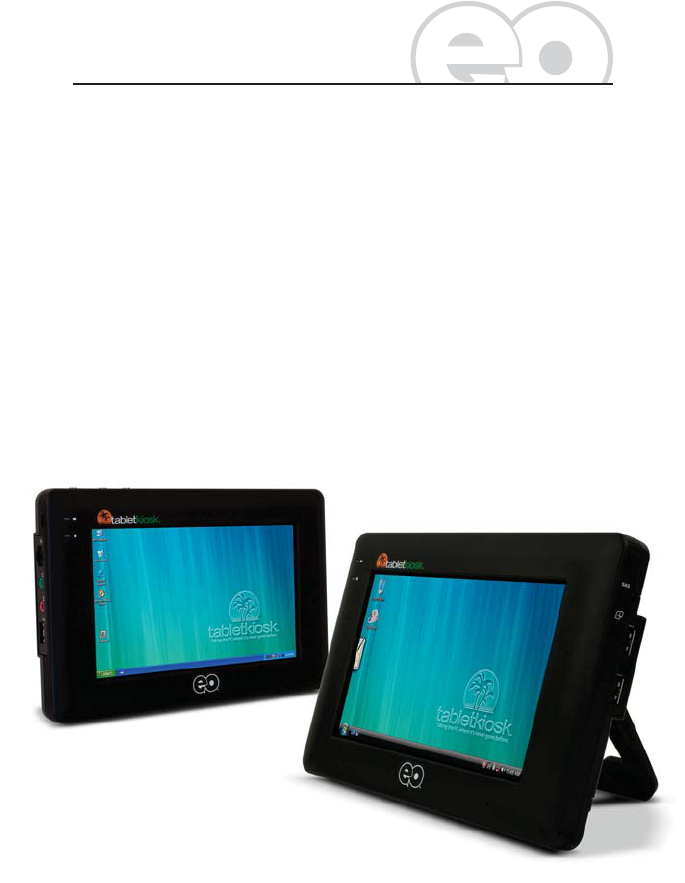
Chapter 02: Touring Your eo Ultra-Mobile PC 9
The eo a7330 Ultra-Mobile PC features a number of physical
characteristics designed to help you work as efficiently as
possible. Take a moment to familiarize yourself with the controls
and Input/ Output (I/O) ports on the faces and sides of the
computer. Understanding the layout of the system will help you
use your eo a7330 more efficiently while in the field or on-the-go.
Chapter 02
Touring Your eo Ultra-Mobile PC
The eo a7330T features a resistive touch screen,
while the eo a7330D features an all new auto-switching,
dual mode digitizer/touch screen by Wacom that is also
sunlight viewable.
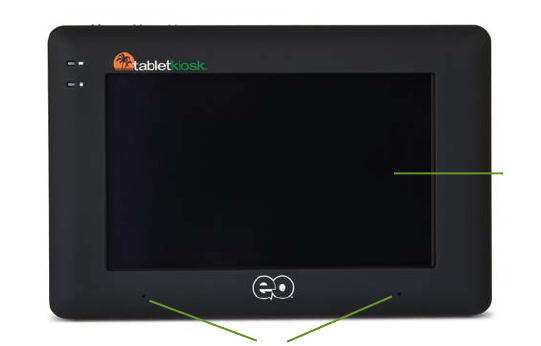
10 Chapter 02: Touring Your eo Ultra-Mobile PC
Front View
1. Battery Charge Indicator
Glows amber when the battery is charging and changes
to green when the battery is fully charged. Glows Orange
when charge drops below 10% and blinks when below 2%.
Doesn’t light up when running on battery unless in a low
state as mentioned.
2. Hard Disk Drive Activity Light
Blinks blue when the hard drive is being accessed.
3. Dual Digital Microphone Array
Microphone array records audio with higher fidelity for more
accurate voice recognition. Recording input source can be
toggled between the internal array and an external audio
source plugged into the Audio In port (see $ in the Left
Side View section later in this chapter) via the Realtek Audio
Control Applet.
!
@
#
$
Chapter 02: Touring Your eo Ultra-Mobile PC 11
4. Auto-Switching Dual Mode Screen (a7330D only)
Screen mode is set to Touch Screen by default. When the
stylus pen’s writing tip is within sensing distance—approxi-
mately 12-15mm—the screen will automatically switch to
Active Digitizer mode. When the pen’s writing tip is moved
away from the screen, it will switch back to Touch Screen
mode. When in Digitizer mode, the screen is not sensitive
to touch (except by the stylus pen’s writing tip), and thus
resting your hand on the screen while writing or navigating
will have no influence on the pointer’s position.
4. Passive Resistive Touch Screen (a7330T only)
Touch Screen is responsive to touch by any object, as the
screen’s sensors react purely to pressure, as opposed to a
magnetic tip or electrical conduction. Resting your hand
on the screen while writing or navigating may affect the
pointer’s position.
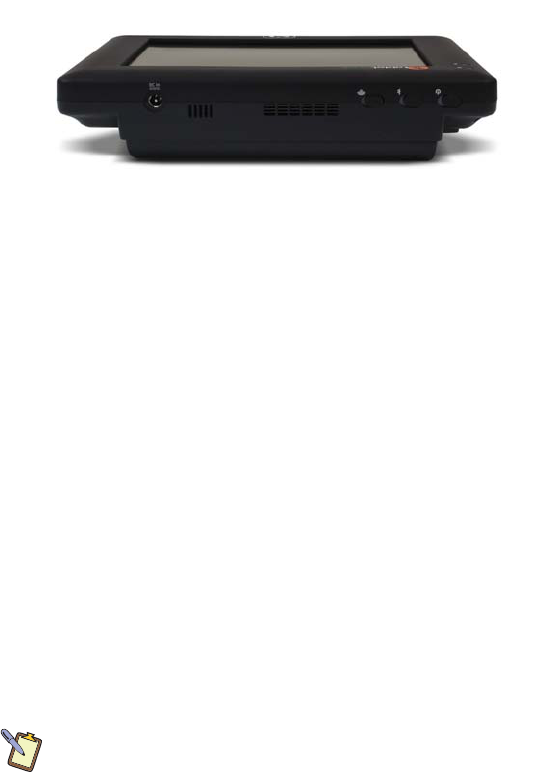
12 Chapter 02: Touring Your eo Ultra-Mobile PC
Top View
1. DC Power In Jack
Plug the AC adapter’s connection cable into this port to
provide power to the computer.
2. Built-in Speaker
To listen to music, movies, games and more.
3. Ventilation Port
Fan exhaust port for expelling hot air from the interior of the
eo Ultra-Mobile PC. Do not block to prevent over heating.
4. Wireless Networking Power Toggle
Slide the toggle switch to activate the wireless networking
adapter’s transmitter and/or the optional 3G data module’s
transmitter (if installed). The switch will glow blue when the
WiFi adapter is powered on, amber when the 3G module is
powered on, and both (purple) when both are active. Slide
switch back to turn off all wireless networking. Use the
wireless mode toggle button to change wireless modes (see
( in the Front View section earlier in this chapter).
NOTE: When not connected to a wireless network, turn off the wireless
transmitter to conserve battery power.
!@ # $%^

Chapter 02: Touring Your eo Ultra-Mobile PC 13
5. Bluetooth Power Toggle
Slide the toggle switch to activate the Bluetooth wireless
transmitter. The switch will glow blue when powered on.
Slide switch back to turn off Bluetooth.
NOTE: When not actively using a Bluetooth peripheral, turn the
Bluetooth transmitter off to conserve battery power.
6. System Power/Resume Toggle
Slide this switch and hold for 1-2 seconds to power on the
computer or to resume normal operation if the computer
is in Suspend Mode. Slide and holding for 4-6 seconds to
immediately turn off the computer.
NOTE: Using this switch to power off the computer is not recom-
mended unless the computer has stopped responding to user input as
there is no time for the OS to shut down normally, and as a result, data
loss may occur.
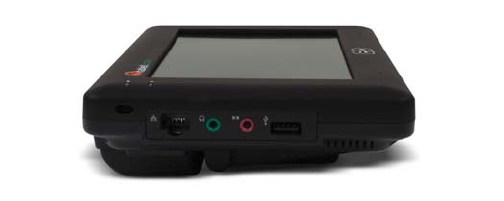
14 Chapter 02: Touring Your eo Ultra-Mobile PC
Left Side View
1. Anti-Theft Kensington Lock
Use with the locking device (sold separately) to attach the
eo Ultra-Mobile PC to a desk, table, kiosk, or other stationary
apparatus to help prevent the computer from being stolen.
2. Ethernet LAN Port
Use this RJ45 jack to access a local area network or high-
speed Internet connection with a standard, twisted-pair
Ethernet cable. Supports 10/100/1000 Mbps protocols.
3. Headphone / Audio Out
Stereo audio port for connecting headphones, external
speakers or other audio devices.
4. Audio In
Used to input stereo audio from external devices such as a
microphone, radio or tape player.
5. USB 2.0 Port
High speed (480 Mbps) Universal Serial Bus 2.0 ports for
connecting peripherals such as a mouse, keyboard, wedge
reader, CD/DVD drive, printer, digital camera and more.
Backward compatible with USB 1.1 devices.
6. Ventilation Port
Cooling fan intake port. Do not block to help prevent
overheating.
!@#$% ^
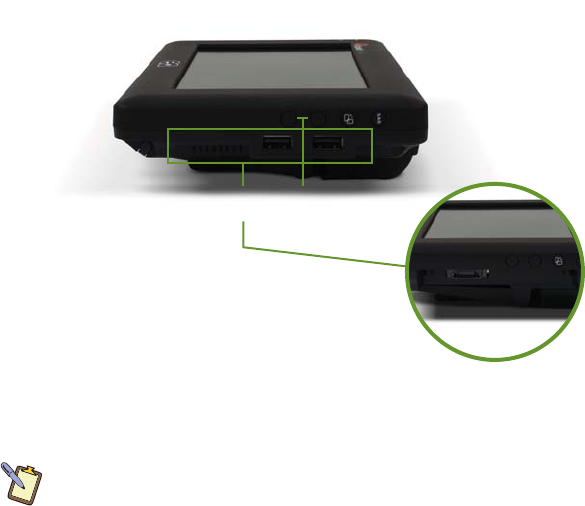
Chapter 02: Touring Your eo Ultra-Mobile PC 15
Right Side View
1. Stylus Pen and Holder
Secures the stylus pen to the eo a7330.
2. Expansion Module Port
(USB 2x2™ Module pictured above)
Plug-in expansion module port allows for the optional plug
and play addition of feature modules including 3G/3.5G
WWAN, CCD Reader, Magnetic Stripe Reader, and more.
NOTE: The a7330D includes the above pictured USB 2x2 Module that
features two (2) High Speed USB 2.0 Ports.
3. User Programmable Function Buttons
These two buttons can be programmed by the user.
4. Screen Rotation (User Programmable)
By default, this button will rotate the screen counter-
clockwise 90º to a portrait orientation and then back to the
original landscape orientation. This button can be repro-
grammed by the user.
5. Secure Attention Sequence (SAS)
A computer without an attached keyboard must support
a hardware mechanism to generate the SAS which is also
known as “CTRL+ALT+DEL” or “CAD”.
!@#$%
Expansion port
sans module.
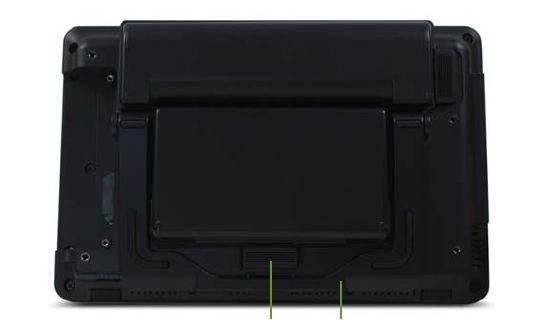
16 Chapter 02: Touring Your eo Ultra-Mobile PC
Back View
1. Main Battery Release Tab
Holds main battery in its port. Pull tab away from the battery
and hold to allow for battery removal.
2. Main Battery Pack
The eo a7330 comes standard with a 4-cell Lithium-Ion
battery pack that provides for up to 4~5 hours of system
runtime.
3. Expansion Module Port
Plug-in expansion module port allows for the optional plug
and play addition of feature modules including 3G/3.5G
WWAN, CCD Reader, Magnetic Stripe Reader, and more.
4. Stylus Pen and Holder
The holder secures the stylus pen to the eo a7330. Simply
slide out the stylus for use.
5. Secondary Battery Release Tab
Holds secondary battery in its port. Pull tab away from the
battery and hold to allow for battery removal.
!@
#
$
*
**
%^
*
&

Chapter 02: Touring Your eo Ultra-Mobile PC 17
6. Fold Out Stand
Built-in stand swings out allowing the a7330 to stand
upright.
7. Secondary Battery Pack
The eo a7330D comes standard (optional for the a7330T)
with a 2-cell Lithium-Polymer battery pack that, in addition
to the main battery pack, provides for approximately seven
(7) hours of system runtime.
8. VESA Mounting Screw Holders
Used to allow mounting with 75mm – 100mm VESA compat-
ible attachments.
Bottom View
1. Docking Cradle Connector
This connector will allow the use of optional expansion
devices such as the a73DC Docking Cradle. Power pass-thru
is supported.
!


Chapter 03: Battery Usage and Care 19
Depending on your system’s configuration and your application
usage, a fully charged Lithium-Ion main battery should allow
you to run your eo Ultra-Mobile PC for 4 ~ 5 hours. Add the
secondary Lithium Polymer battery and you could see more than
7 hours of runtime.
Operations that will significantly reduce battery life include, but
are not limited to, the following:
1. Using external bus-powered USB optical, floppy and hard
disk drives
2. Using wireless communications devices, including the
internal wireless networking card, optional 3G data module
Bluetooth adapter, or bus powered USB devices.
3. Using high-brightness display settings, 3D screen savers, or
other computationally intensive programs such as games,
media players and 3D graphics applications.
4. Running the computer in maximum performance mode.
5. Using the computer in overly-hot environmental conditions.
Using the Battery for the First Time
Before using the computer on battery power for the first time,
the battery should be charged for at least four hours. Also, the
Smart Battery IC within the battery pack should be calibrated in
order to get an accurate reporting of the remaining battery life.
Chapter 03
Battery Usage and Care
20 Chapter 03: Battery Usage and Care
To calibrate the battery pack, follow these steps:
1. Turn the computer off. Connect the AC adapter and let the
battery fully recharge.
2. Disconnect the AC adapter and power on the computer.
Let the battery run down until it is so low that the battery
charge light turns red and the system automatically enters
the Suspend mode.
3. Reconnect the AC adapter, let the battery fully recharge and
then run the computer with the external power still con-
nected for at least five (5) continuous hours.
The battery pack should now be properly calibrated. If you find
that battery life doesn’t correspond to the battery status as
reported by your operating system, repeat steps 2 -3 again.
If after performing a calibration for a second time you still find
you are having a problem with the battery life, contact your
dealer and arrange for a replacement. The battery may be
defective.
In general, using the battery until the “Battery Low” warning
indicator appears and then fully recharging the battery (full
discharge/charge cycle) will ensure the accuracy of the battery
status gauge.
If you find you are using the computer almost exclusively
attached to an external power source, calibrating at least once a
month is recommended.
Charging the Battery Under Typical Conditions
When you connect the computer to an electrical outlet, the
Smart Battery IC in the battery pack checks the battery’s charge
and temperature. If charging is necessary, the battery indicator
on the front of the eo a7330 will glow amber and the AC adapter
will automatically charge the battery.

Chapter 03: Battery Usage and Care 21
When fully charged, the battery indicator will change to green
and the battery’s charge will be maintained while connected to
the external power source. When the computer is disconnected
from the electrical outlet, the battery indicator will turn off.
NOTE: The time to fully recharge the battery is approximately 90 ~ 100
minutes when the computer is powered off. The time to fully recharge
the battery when the computer is in use varies according to the power
requirements of the operations that the computer is performing while
charging.
Problems Charging the Battery
Environmental conditions can affect the ability of the computer
to charge the battery. If the battery is too hot from either being
used in your computer or being exposed to an overly hot
environment, the battery may not charge when you connect the
computer to an electrical outlet.
If this occurs, disconnect the computer from the electrical outlet
and allow it and the battery to cool to room temperature. Then
reconnect the computer to an electrical outlet to continue
charging the battery.
Battery Status
Both Windows XP and Windows Vista have an applet in the
Control Panel that will display an icon in the Windows taskbar
indicating when the computer is running on battery power or is
attached to the AC adapter.
This applet also displays a meter that indicates approximately
how much of a charge is remaining in the battery.
Low Battery Warnings
A beeping sound will be heard once to alert you to a “Battery
Low” status. The Battery LED indicator will begin to flash red.
When the battery’s power level drops to a “Battery Very Low”
status the beeping sound will be heard every second.

22 Chapter 03: Battery Usage and Care
When this continuous beeping occurs, your battery has only
approximately one to two minutes of charge left. You should
save what you are working on and plug in the AC power adapter
to avoid potential data loss.
When there is only one minute of battery charge remaining, the
computer will suspend its current state to the hard drive and
power off. Plug in the AC adapter and turn the computer back on
to resume your work.
About Battery Pack Usage
Over time, even with proper care, battery performance (the time
the battery can operate the computer before needing to be
recharged) will decrease. Depending on how often the battery
is used, how many times it has been charged and the conditions
under which it is used, you may need to purchase a new battery
during the life of your computer.
IMPORTANT: To avoid damage, only use replacement batteries recom-
mended by TabletKiosk. To prevent the loss of data when the system
loses power, do not remove the main battery pack while the power is
on unless attached to an external power source. If you must hot swap,
both battery packs must be attached to the eo a7330, and we recom-
mend putting the system into a sleep or hibernation state.
NOTE: Do not dispose of batteries with household waste. When your
battery no longer holds a charge, call your local waste disposal or
environmental agency for advice on disposing of a lithium-ion or
Lithium Polymer battery.
Real Time Clock Battery
In order to maintain certain system information while the power
is off, the motherboard contains a small built-in battery pack that
constantly supplies power to the system.
If the computer is left without a power source for long periods
of time, this battery can be exhausted and system information
will be lost. This will not affect any of your data stored on the
computer’s hard drive, but rather the settings in the BIOS that
tell the computer how to operate. It is recommended, therefore,

Chapter 03: Battery Usage and Care 23
that if you plan to store the computer for a long time you
periodically attach the battery pack, plug in the computer to an
external power source and allow the battery to recharge.
If you find out, after removing the computer from storage, that
you have lost this system information, by receiving a BIOS error
when you boot up for the first time, contact your dealer or visit
TabletKiosk’s website at www.tabletkiosk.com to obtain the
proper BIOS settings.
Storing a Battery
When storing your computer for an extended period of time, it is
recommended that you remove the battery pack and store it in
a dry, cool location (Do not freeze). Also, we recommend storing
the battery with a 40 - 50% charge.
If you store the battery when it is fully discharged, it is possible
that the battery could fall into a deeply discharged state. This
can cause the battery to loose its ability to hold any charge at all.
Conversely, storing a fully charged battery can cause damage to
the storage cells rendering its total charge capacity to become
prematurely diminished.
Since a smart Lithium-Ion battery slowly discharges during
prolonged storage, you should fully recharge the battery before
you use it again. Additionally, you should consider periodically
charging and discharging a battery in long term storage to
promote optimal battery performance and life.
TIP: If storing the batteries for a long period of time, we recommend
charging and discharging the Lithium-Ion main battery every 1 - 2
months, while we recommend every 2 -3 months for the Lithium
Polymer secondary battery. Remember to bring the charge level to
approximately 40 - 50% capacity before replacing into storage.


Chapter 04: Using Your eo a7330 with Windows 25
While your eo a7330 Ultra-Mobile PC is a versatile, mobile com-
puter capable of accomplishing all the same tasks as a netbook,
and running most all the same applications as standard laptops
and desktop PCs, there are some differences in the way that you
interact with Windows using a stylus pen, or your fingers, as op-
posed to a mouse and keyboard. This chapter contains tips and
details to get the most from your eo a7330 while using Windows.
Navigating with the Stylus Pen
With an Ultra-Mobile PC, you use a stylus pen or your fingers in-
stead of a mouse to interact directly with objects on your screen.
You can open, move, edit and delete items — such as icons, files,
windows and more — with easy-to-use basic functions similar to
those performed with a mouse.
Stylus Pen Action Equivalent Mouse Action
Point Point
Tap Click
Double-tap Double-click
Press and hold Right-click
Drag Drag
Hold the stylus pen as if you were writing with a standard pen.
Instead of sliding the pen around on the screen, just tap on
what you want to interact with. In digitizer mode (a7330D only),
moving the stylus pen’s tip just above the screen will cause the
Chapter 04
Using Your eo a7330 with Windows

26 Chapter 04: Using Your eo a7330 with Windows
pointer to follow along similarly to how it behaves when moving
a mouse. Sliding the pen while lightly touching the tip to the
screen will move the on-screen pointer around as if you were
using a mouse and holding down the left mouse button. In
other words, you would be performing what is known as a drag
operation.
Also, remember that since the screen is sensitive to the touch,
resting your hand on the screen while using the stylus pen might
make the pointer react unpredictably. Actually, this is only true
with the eo a7330T, as when using the stylus pen with an eo
a7330D the screen will automatically switch to digitizer mode
which is not touch sensitive except to the pen’s tip.
It is also important to note that some of the context-sensitive
features of Windows XP Tablet PC Edition and Windows Vista,
such as the floating Input panel icon, will only function when
you are using the pen and your eo a7330D is in Active Digitizer
mode.
Touch Screen Settings and Calibration
Wacom’s “Touch Settings” Control Panel allows you to custom-
ize the way your touch screen behaves as well as calibrate the
screen for more accurate input.
1. Go to the START Menu and tap on
“Control Panel” in the right hand
column.
2. From the Control Panel window,
double-tap on the “Touch Settings”
icon to open the control panel.
Right-Click Emulation
You can enable and disable the “Right-Click” emulation by
tapping the check box in the “Press-and-Hold-to-Right-Click”
section, as well as set the duration that you must hold before a
“Right-Click” is performed by adjusting the slider.
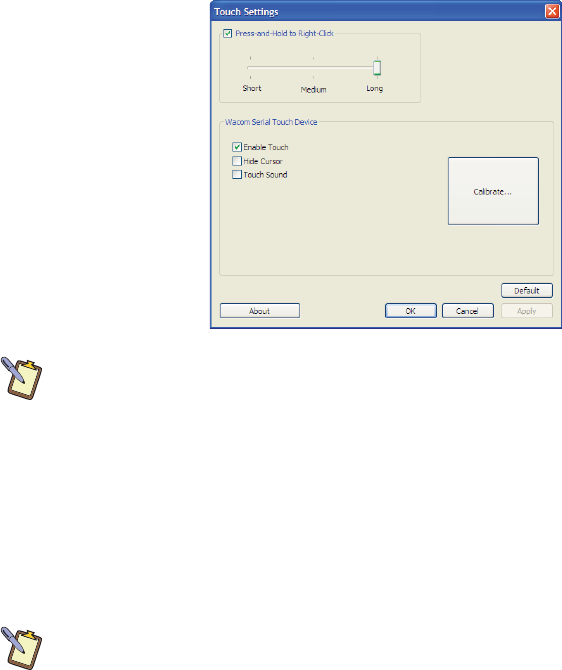
Chapter 04: Using Your eo a7330 with Windows 27
Touch Screen Behavior
The following check
boxes will alter the way
that the touch screen
behaves. These options
have no affect on how
the screen behaviors
when in digitizer mode
(a7330D only).
Enable Touch
The “Enable Touch”
check box allows you
to enable and disable
the touch screen.
NOTE: a7330T owners should be careful, for if you disable the touch
screen you will need to attach a keyboard or mouse in order to
navigate and interact with your system. a7330D users can still use the
digitizer. This essentially turns the a7330D into a pen only system.
Hide Cursor
The “Hide Cursor” check box will hide and show the mouse
pointer when interacting with the touch screen. When this
feature is enabled, the cursor will not be visible when in touch
mode. This is handy for using your system as a button driven
touch screen kiosk or controller.
NOTE: a7330D users, when the proximity of the stylus pen’s tip auto-
switches the screen to digitizer mode, the cursor will appear. Tap on
the screen with something other than the pen’s tip to return to touch
screen mode and re-hide the pointer.
Touch Sound
The “Touch Sound” check box will enable an audible beep to be
produced when the touch screen registers an input. This can be
helpful for supplying kiosk customers or a remote controller user
some feedback to let them know that their input was accepted
(i.e. a button press was registered, etc.).
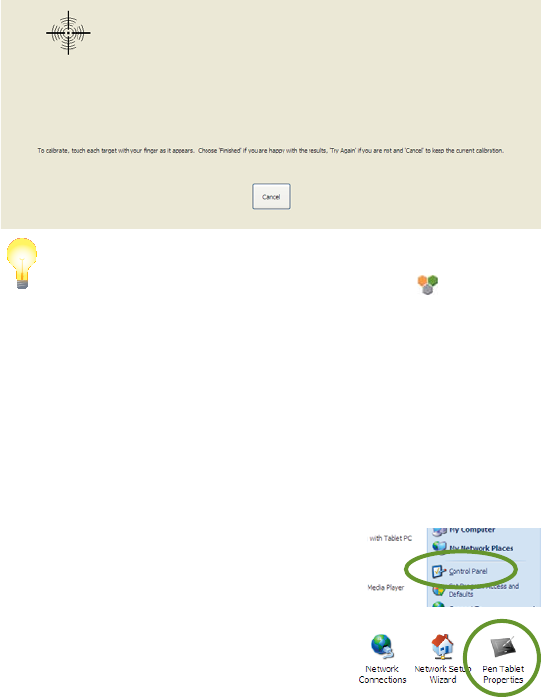
28 Chapter 04: Using Your eo a7330 with Windows
Calibrating the Touch Screen
Tapping the “Calibrate...” button will initiate the system’s touch
screen calibration routine. Simply follow the instructions that
appear on screen and tap the center of the targets with your
finger. When done, tap the “Finished” button to accept your
calibration input and exit, tap “Try Again” to redo the calibration
routine, or tap “Cancel” to quit without saving the new calibra-
tion information.
TIP: A quick way to access the both the Touch Screen and Digitizer
(a7330D only) calibration routine is to use the “Pen” screen in the
“Panel Control Center”. Simply press and hold on the icon in the
system tray to bring up the “Launch Button Quickshow” menu. Tap the
“Configure...” button to open the Panel Control Center and then tap
the “Pen” button. Tap the “Configure...” button and choose the input
screen to wish to calibrate.
Digitizer Settings and Calibration (a7330D only)
Wacom’s “Pen Tablet Properties” Control Panel allows you to
customize the behavior of the Stylus Pen as well as calibrate the
digitizer for more accurate input.
1. Go to the START Menu and tap on
“Control Panel” in the right hand
column.
2. From the Control Panel window,
double-tap on the “Pen Tablet
Properties” icon to open the
control panel.
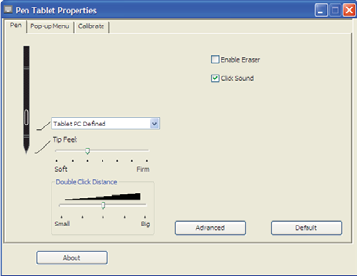
Chapter 04: Using Your eo a7330 with Windows 29
Pen Tab
The options on this
tab will adjust the
behavior of how
the pen interacts
with the digitizer as
well as how the pen
itself will behave.
Pen Button Action
The button on the
side of the stylus
pen can be pro-
grammed to perform a wide variety of tasks, including a stan-
dard left-button click, a double-click, a right-click, opening the
Tablet PC Input panels (see the section entitled “Entering Text
with the Input Panels” later in this chapter), entering a keyboard
keystroke combination, opening a program, and more.
Pen Tip Options
The “Tip Feel” slider adjusts how much pressure you must apply
to the screen to change the amount of input by the pen. This is
primarily for applications that recognize different levels pressure
sensitivity (i.e. the inking pen in Microsoft® OneNote™ or the
paint brush tool in Adobe® Photoshop®).
The “Double-Click Distance” slider adjusts how far apart you can
perform two successive taps and still register a mouse “double-
click” action.
Enable Eraser
Checking this box will switch the options on this tab to support
a stylus pen that has an eraser feature. The stylus that comes
standard with the a7330D does not have such a feature.
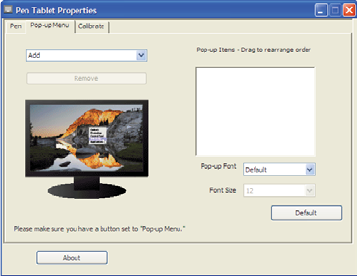
30 Chapter 04: Using Your eo a7330 with Windows
Click Sound
This option is the same as the corresponding feature in the touch
screen settings, except that it will cause the system to make an
audible “clicking” sound when the pen’s tip touches the screen
while in digitizer mode.
Advanced Settings
Tapping on the “Advanced” button opens the “Advanced Set-
tings” window where you can specify how the pen’s side button
will function.
“Hover Click” mode means that in order to perform the action
associated with the pen’s side button, all you have to do is hold
the pen tip near enough to the screen to activate digitizer mode
and then press the button.
“Click & Tap” mode means that in order to perform the action
associated with the pen’s side button, you must first press and
hold down the button and then tap on the screen.
Pop-Up Menu Tab
In order to perform
common actions
more quickly and
easily, you can use
the controls on
this tab to create
a custom pop-up
menu, filled with
whatever entries
you build from the
drop-down of op-
tions, that appears
when you press the
pen’s side button if you set the button’s action to “Pop-up”.
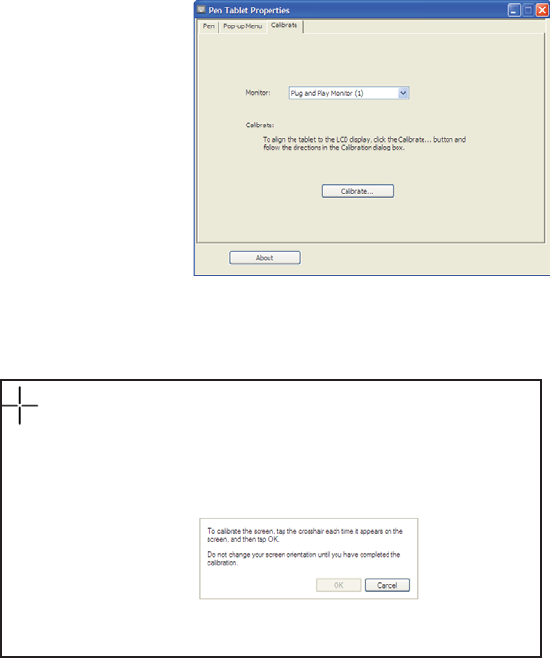
Chapter 04: Using Your eo a7330 with Windows 31
The sort of actions you can add to the pop-up menu includes
keystroke combinations, opening specific applications, and
changing the pen’s follow mode between “pen” and “mouse”.
You can also choose the font face and the font size that will
display in the pop-up menu.
Calibrate Tab
This is where you will
find the digitizer’s
calibration routine.
Simply tap the
“Calibrate...” button
to start the calibra-
tion. As with the
touch screen, simply
follow the on-screen
instructions and tap
in the center of each
cross that appears on
the screen. When
finished, you can choose to save and exit the routine, or cancel
and not save when you exit.
The digitizer calibration is very similar to the touch screen calibration.
Touch the center of the crosses when they appear.
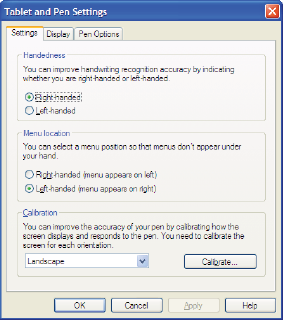
32 Chapter 04: Using Your eo a7330 with Windows
Windows Tablet and Pen Settings Control Panel
Besides the Wacom control panel, Windows XP Tablet PC Edition
also features its own control panel.
To access the “Tablet and Pen Settings” control panel:
1. Tap on the START button to open the START Menu.
2. Tap on the “Control Panel” and then in the Control Panel
window that opens, tap on the “Printers and Other Hard-
ware” category.
3. From the “Printers and Other Hardware” window, look under
“or pick a Control Panel icon” for “Tablet and Pen Settings”
and tap to open the control panel.
This control panel will allow
you to set your handedness,
where menus open, the
default screen rotation,
what mouse actions occur
with different pen actions
and more. You can tap on
the “Help” button for more
information on each of the
individual features in the
panel.
Another important feature
of the “Tablet and Pen
Settings” control panel can
be found on the “Settings” tab: it is the Digitizer Screen Calibra-
tor. For improved accuracy, you can independently calibrate the
digitizer screen for both landscape and portrait orientations.
Choose the orientation from the drop down list and then tap on
the “Calibrate…” button to start the calibration routine. Follow
the on-screen instructions to complete the calibration. This is the
same routine as from Wacom’s “Pen Tablet Properties” Control
Panel.
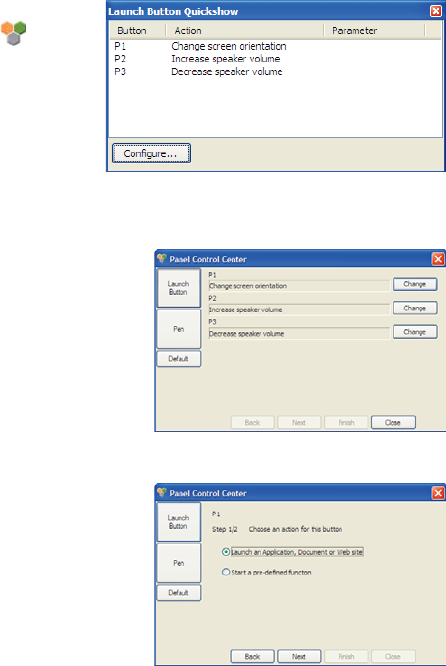
Chapter 04: Using Your eo a7330 with Windows 33
Programming the Function Buttons
Your eo a7330 has three user-programmable function buttons
located on the right side of the eo. You can use the “Launch
Button” screen in the “Panel Control Center” to reprogram the
buttons to activate a different preprogrammed task, or to launch
a “Custom” application of your choice.
To program a function button:
1. Press and hold
on the icon in
the System Tray
to open the
“Launch Button
Quickshow”
panel that will
give you a
summary overview of the functions mapped to each of the
buttons along with any custom parameters.
2. Tap the “Configure...”
button to open the
Panel Control Center. By
default, the “Launch
Button” screen will be
displayed.
3. Choose the button you
wish to program and
then tap the appropriate “Change” button.
4. On the screen that
appears, choose either
to open an application,
document or web-
page; or to pick from
a list of pre-defined
functions. Then tap the
“Next” button.
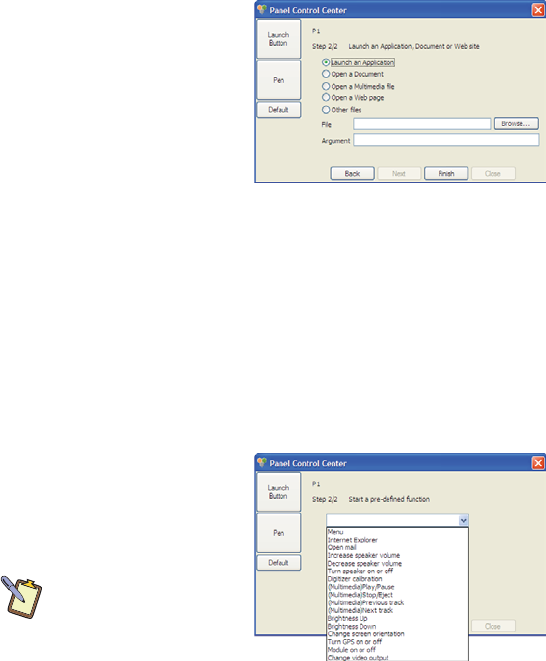
34 Chapter 04: Using Your eo a7330 with Windows
Opening an Application, Document or Web Page
5. Using the option
buttons, choose the
appropriate file type
you’d like to open.
6. Go down to the “File”
field— or “URL” field
if you chose to open
a web page—and
either type in the exact path to the file/program or tap
the “Browse...” button and navigate to it. You will have to
enter the exact URL if you chose to open a web page as no
“Browse...” button is available. You can, however, copy &
paste a URL from your web browse.
7. Enter any program arguments, if applicable, and tap the
“Finish” button to commit the change to the button’s func-
tion and return to the “Launch Button” screen.
Assigning a Pre-Defined Function
5. Using the drop-down
list box, choose the
pre-defined function
you’d like to assign to
the button.
NOTE: The first option
in the list box, “menu”,
refers to opening context
sensitive menus. In other
words this is equivalent to
performing a right-click
action.
6. When you are satisfied with your selection, tap on the “Fin-
ish” button to commit the change to the button’s function
and return to the “Launch Button” screen.
If at any point you wish to restore the all the buttons to their
original programmed state, simply enter the “Launch Button”
screen and tap on the “Default” button.
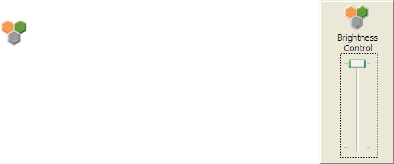
Chapter 04: Using Your eo a7330 with Windows 35
Setting the Screen Brightness
The “Brightness” applet, accessible by simply
tapping on the
p
icon in the System Tray, allows
you to set an overall brightness level for the
display screen. Simply drag the slider down to
dim the display or up to brighten the display. This
control is independent from the sliders in the Intel
Media Accelerator Driver control applet.
Changing Screen Resolution, Color and Rotation
Using the control panel of the Intel Graphics Media Accelerator
Driver, you can enable multi-monitor support, adjust color bal-
ance and gamma, change the screen resolution, enable/ disable
screen rotation and more. This section will get you started with
the control panel. For more detailed information about the
panel’s features, click on the question mark icon located on the
right-hand side of the panel’s title bar.
To access the control panel of the Intel Media Accelerator Driver,
tap on the screen icon located in the Windows system tray.
When the pop-up menu appears, tap on “Graphics Properties…”
to open the panel.
Display Settings
The Display Settings tab holds the controls that affect color
depth, screen resolution and screen rotation. Most of the time
you will probably want to use the default values, but you may
encounter specialized applications where it is advantageous
to lower the screen’s resolution or disable the screen rotation
function.
Display Expansion
By default, the native resolution of the eo a7330’s screen is
1024x600 (16:9 wide screen aspect ratio). The other three screen
resolutions you can change to (640x480, 800x600 and 1024x768)
are standard 4:3 aspect ratios. The “Aspect Ratio Options” panel
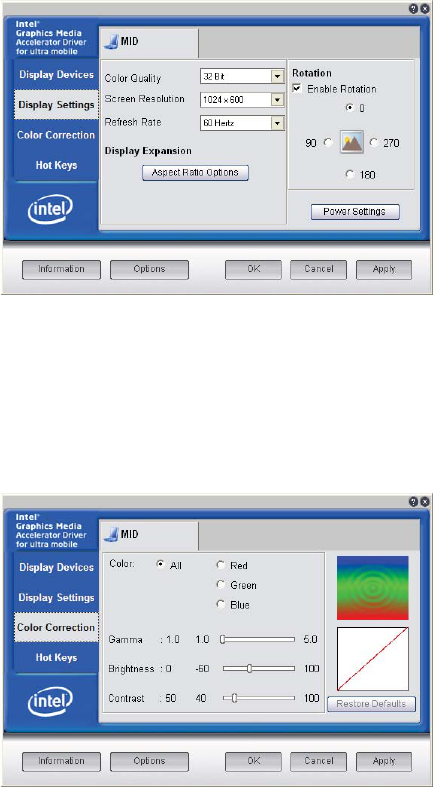
36 Chapter 04: Using Your eo a7330 with Windows
allows you to control how these non-native screen resolutions
will resolve on your display (i.e. stretched or pillar boxed).
Color Correction
The Color Correction tab is where you will find the controls that
affect the color balance, brightness and contrast of the display
screen. Use the control sliders to adjust the screen values.
Moving a slider to the left decreases the corresponding value,
moving a slider to the right increases it.
By using the color channel option buttons at the top of the
panel, you can change the RGB color values equally or individu-

Chapter 04: Using Your eo a7330 with Windows 37
ally. The Gamma control will adjust the screen’s brightness
without affecting the white point or the black point of the
display.
Tap on the “Restore Defaults” button to return the control
settings to their default values. This is useful if you are experi-
menting with the sliders and are unhappy with the results, or if
you decide to make additional changes at a later time and want
to discard your previously-applied settings. Tap on the “Apply”
button to accept your changes, the “Cancel” button to reject the
changes, or the “OK” button to accept the changes and exit the
control panel.
Entering Text with the Input Panels
Complementing Microsoft’s Digital Inking handwriting recogni-
tion technology, Windows XP Tablet PC Edition features input
pads that accept and convert handwriting to text, as well as
provide a more compact and convenient on-screen keyboard.
Tap the “Keyboard” icon located next to the START button on the
Windows Taskbar to display the on-screen keyboard and writing
pads. These input tools allow you to enter information directly
into any application that accepts standard keyboard inputs.
Writing Pad
This pad allows you to enter text on a word-by-word basis. You
write on the lines inside the writing pad just as you would write
on a lined piece of notepaper. When you reach the end of the
line, the pad will expand automatically so you can keep on
writing without having to stop. Windows will convert your
handwriting into text, on the fly, and then insert it in the appro-
priate location when you tap “Insert”.
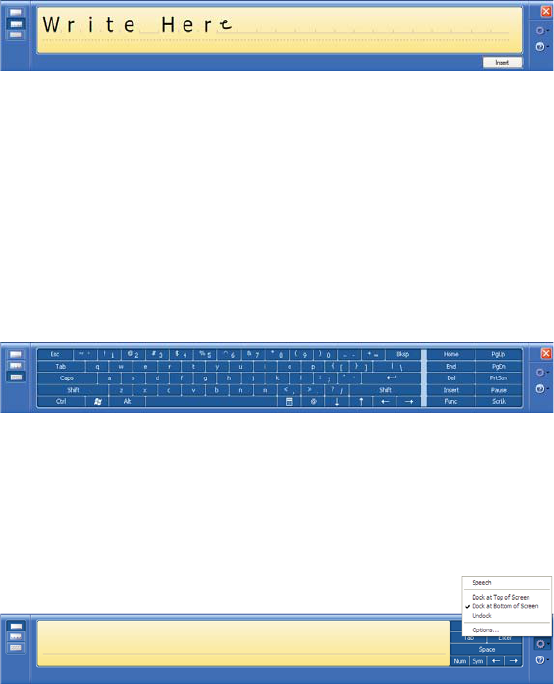
38 Chapter 04: Using Your eo a7330 with Windows
Character Pad
This pad accepts input on a character-by-character basis and is
useful for entering information that requires a higher level of
precision, such as passwords, website URLs or e-mail addresses.
When you reach the end of the line, the pad will expand auto-
matically so you can keep on writing without having to stop.
Windows will convert your handwriting into text, on the fly, and
then insert it in the appropriate location when you tap “Insert”.
On-Screen Keyboard
Use it the same way that you would use a standard keyboard. By
tapping on the individual keys with the stylus, text and symbols
can be entered as well as Function Key equivalents and menu
item short cuts.
Tap the <Num> or <Sym> keys to display the “Numeric” and
“Symbol” keypads respectively. Tap <Func> to bring up the
Function keypad.
Tap on the gear icon, on any of the input panels, to display a
menu that you can use to invoke Windows XP Tablet PC Edition’s
speech recognition capabilities, adjust where you want the input
panels to appear on the screen, undock the panel to move it
anywhere on the screen, or open the panels’ “Options” menu.
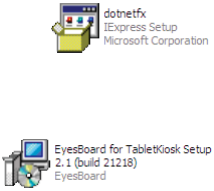
Chapter 04: Using Your eo a7330 with Windows 39
For more information about the Input Panels, refer to the Win-
dows Online Help System by tapping on the “Help and Support”
item inside the START Menu.
To learn more about how to use the input panels, you can also
take the “Tablet PC Tutorials” by navigating to “All Programs >
Tablet PC > Tablet PC Tutorials” in the START Menu. For more
information about the Input Panel’s “Options” menu, tap on the
“Help” button inside of the “Options” Menu Panel.
Entering Text with the Eyesboard™ Virtual Keyboard
A more feature rich and customizable keyboard that comes with
your eo a7330 is the Eyesboard Virtual Keyboard. Eyesboard
features a full standard keyboard plus optional keypads and
function keypads that you can dock or free float around the
screen. You can adjust the size, position, color, opacity and more.
Installing the Eyesboard Keyboard (Tablet PC Edition only)
If your eo a7330 came with Windows XP Tablet PC Edition, you
will have to first install the Eyesboard Keyboard application
before you can use it.
The first thing you must do, before
installing the Eyesboard application, is to
install the Microsoft .NET 2.0 Framework
package located on your desktop. Simply double-tap on the
“dotnetfx” icon to start the installer.
After you have successfully com-
pleted the .NET installation, you can
install the Eyesboard application.
Simply locate the “EyesBoard for TabletKiosk Setup” icon on your
desktop and double-tap on it to start the installation.
Accessing the Eyesboard Keyboard
To access the Eyesboard Keyboard, just double-tap on its icon
located on the desktop. For more information on using and
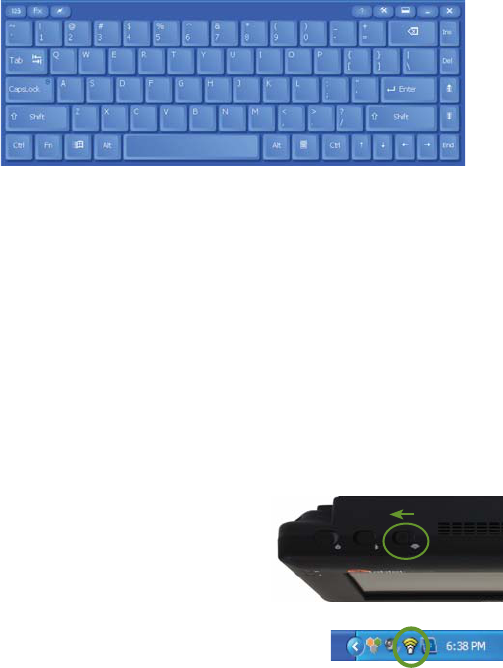
40 Chapter 04: Using Your eo a7330 with Windows
customizing the Eyesboard to suit your tastes and working style,
you can access the help file by tapping on the “?” button in the
upper right hand corner of the keyboard.
Connecting to the Internet
Your eo a7330 allows you to connect to the Internet in a few
different ways. The ways vary depending on your networking
environment as well as personal preference and available equip-
ment.
Using a Wireless LAN
The WiFi wireless networking adapter built into your eo a7330 is
compatible with 802.11a/b/g/n (Draft 2.0) wireless networks, and
can therefore connect to wireless routers or access points that
support any of these standards.
1. Turn on the WiFi transmitter
using the toggle switch on the
top of your tablet.
2. In the System Tray, tap on
the Intel PROSet icon and choose
“Configure WiFi” from the pop-up
menu that appears.
3. When the Intel® PROSet/Wireless WiFi Connection Utility
opens, choose the network from the list that you wish to
connect to and tap the “Connect” button. If no wireless
networks appear after a few moments, tap on the “Refresh”
button located just below the list.
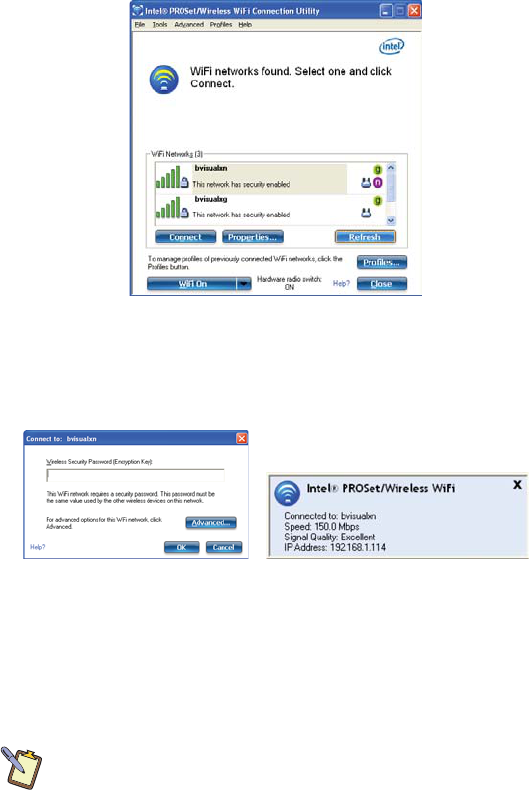
Chapter 04: Using Your eo a7330 with Windows 41
4. If the wireless network you are attempting to connect to is
security-enabled, you will see a dialog box requesting either
a network key or, if the wireless network supports WiFi
Protected Setup (WPS), a PIN.
Most failures to connect to a wireless network occur because the
network key has been improperly entered. Be very careful when
entering this key. If you do not know the correct key to enter,
or still can’t connect after entering the key properly, contact
your network administrator or the technical support line of your
Internet Service Provider (ISP).
NOTE: If your network access point or router uses WiFi Protected
Set-up, the WPS Wizard will appear on the screen. Choose your access
point from the drop-down list, enter your PIN when prompted. Unless
you need to configure your access point/router for the first time, just
tap on the “No” button when asked. If you entered your PIN properly,
you should see the same pop-up window informing you that you are
connected. Check with your Network Administrator or the instructions
that came with your access point/router for locating the PIN.
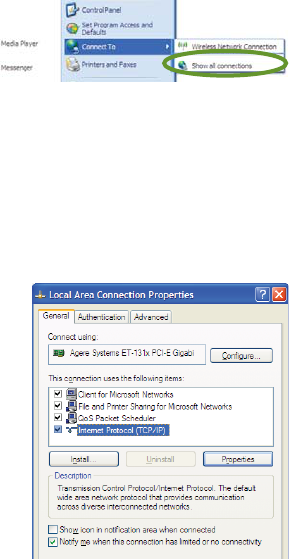
42 Chapter 04: Using Your eo a7330 with Windows
Using a Wired LAN
Another way to connect to the Internet with your eo a7330 is by
a wired LAN environment accessed via the RJ45 port located on
the left side of the a7330 (see the chapter Touring Your eo a7330
for the exact location). Using this method, an Ethernet jack or a
broadband modem must be within the reach of the networking
cable you are using.
1. Connect an Ethernet networking cable into the LAN port of
your eo a7330 and then connect the other end into your
broadband modem or the appropriate LAN port as in-
structed by your network administrator. Most of the time,
you will probably find that you are now connected to the
Internet. If not, continue on with step 2.
2. From the START menu,
select “Connect To”
and tap on “Show all
connections”.
3. In the “Network Connections” window, look at the “Local
Area Connection” item and make sure it reads as “Connect-
ed”. If not, recheck that your networking cable is properly
connected, or contact your network administrator.
4. Press and hold the “Local Area Connection” item and select
“Properties” from the pop-up menu that appears, or if the
Status window appears, tap the “Properties” button.
5. Under the General Tab,
you’ll see a list box called
“This connection uses the
following items:”. Select
“Internet Protocol (TCP/
IP)”, and tap the “Proper-
ties” button to open the
“Internet Protocol (TCP/IP)
Properties” window.

Chapter 04: Using Your eo a7330 with Windows 43
6. If DHCP is used on your
network, tap “Obtain an IP
address automatically” and
“Obtain DNS server address
automatically”. Otherwise,
enter the correct IP and DNS
server addresses by selecting
the two options that begin
with “Use the following…” If
you are unsure of which
option to use, contact your
network administrator or
your ISP’s Tech Support.
7. After entering the correct the information in the “Internet
Protocol (TCP/IP) Properties” window, tap “OK” to accept
your changes and close the window. Tap “OK” in the “Local
Area Connection Properties” window to finish.
Using Both DHCP and a Static IP Address
If you are using alternating networks with either DHCP or static
IP addressing, you can use alternative settings that will enable
simultaneous configurations of both DHCP and a static IP. This
will allow you to connect to both of the networks without having
to reconfigure each time you want to switch.
1. Follow steps 1 through 7
above when using a wired
LAN connection.
2. Tap on the “Alternate
Configuration” tab
and select the “User
configured” option. Enter
the correct values in
the appropriate fields. If
you are unsure of which
values or options to use,

44 Chapter 04: Using Your eo a7330 with Windows
contact your network administrator or the technical support
line of your ISP.
When you have completed the entire configuration, tap “OK” to
accept the settings and close the panel.
Bluetooth® Wireless Connectivity
Bluetooth® is a short-range wireless technology you can use to
transfer data between your eo a7330 and other wireless devices
that use Bluetooth, such as wireless keyboards and mice, cell
phones, PDAs and even printers. Bluetooth-enabled devices can
communicate with each other, without cables, up to a distance
of approximately 30 feet.
NOTE: The wireless range can be shortened from interference caused
by other wireless devices and/or by walls made of dense building
materials.
Some of the activities available with Bluetooth wireless con-
nectivity are:
Using a wireless keyboard, such as TabletKiosk’s Bluetooth
Folding Keyboard, to enter data on your eo a7330.
Connecting to your Bluetooth-capable cell phone to access
the Internet and surf the web or download your e-mail.
Setting up a Personal Area Network (PAN) to transfer files
between your eo a7330 and another computer without the
need of using Ethernet cables or even an existing wireless
network.
Print to a Bluetooth-enabled printer from across the room
without connecting any cables.
Bluetooth Device Registration and Pairing
Different types of Bluetooth devices require slightly different
procedures to register and pair them properly. Generally, to
connect your eo a7330 to a Bluetooth enabled device:
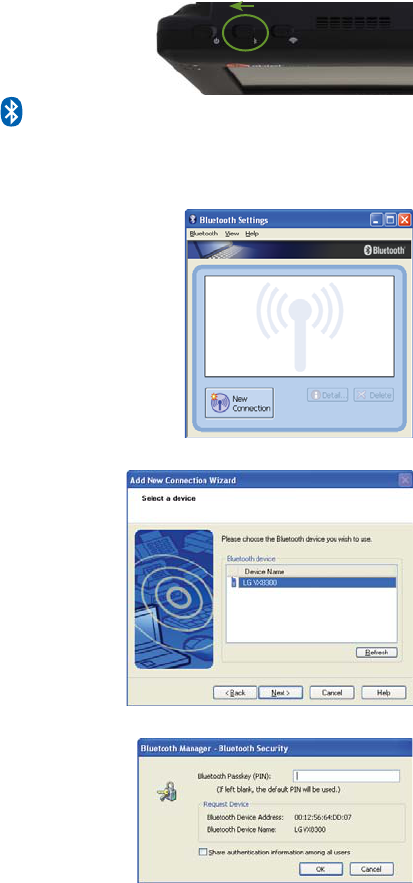
Chapter 04: Using Your eo a7330 with Windows 45
1. Turn on the Bluetooth
transmitter using the
toggle switch on the top of
your tablet.
2. Locate the icon in the System Tray and double-tap on the
icon to open the Bluetooth Settings Manager. Alternatively,
you can just double-tap on the icon to open the Bluetooth
Settings Manager.
3. When the Bluetooth Settings
Manager opens, tap on the
“New Connection” button to
start the “Add New Connec-
tion Wizard”.
4. Place your Bluetooth device
into “Discovery Mode”
(you will have to consult
your Bluetooth device’s
instruction manual if you
do not know how to
accomplish this task)
and then tap on the
“Next >” button to start
the Discovery process.
5. When your Bluetooth
device is found, tap on
it in the list and then
tap “Next >” to initiate
the Pairing process.
6. If a dialog box opens on
the eo a7330’s screen
asking you to input
a Bluetooth Passkey,
enter the number that
appears in the window
on your screen into
your Bluetooth device
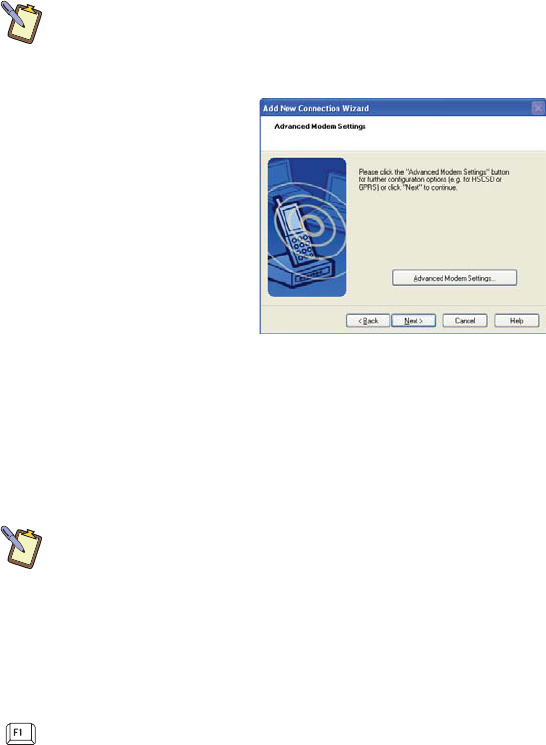
46 Chapter 04: Using Your eo a7330 with Windows
and, if applicable, hit <Enter> or <OK> on the Bluetooth
device to commit the entry.
NOTE: Check “Share authentication information among all users”, if
you want all user accounts on the system to have access to the
Bluetooth device. Leave this unchecked if you want only your user
account to be able to connect to the Bluetooth device.
7. Your device should
now be connected to
your eo a7330. If any
advanced settings are
required, you will be
prompted to enter
them. When complete,
you should be returned
to the Bluetooth
application screen and
your device should be
listed.
If you have trouble connecting, make sure you completed the
above steps in the time period that your Bluetooth device is in
pairing mode. If your device exits pairing mode before you can
connect, re-enable it and, depending on the state of the connec-
tion process, redo any applicable steps.
NOTE: Once a device has been registered, you usually won’t need to
register it again. You will, however, have to pair it. When you see this
window upon system start-up, just place your device into pairing
mode and it should connect automatically. If you do not wish to
automatically connect a Bluetooth device at start-up, you can check
the “Don’t show this windows next time” check box and tap the
“Cancel” button.
For more information about configuring and using the Bluetooth
application, check out the online help system by either tapping
on your keyboard or choosing “Help” from the Bluetooth
application menu.
Chapter 04: Using Your eo a7330 with Windows 47
This Page Left Blank Intentionally


Chapter 05: Securing Your eo a7330 49
Chapter 05
Securing Your eo a7330
Your eo a7330 is equipped with a Trusted Platform Module (TPM)
that, when used in conjunction with specialized software, can
help you better secure your data from intruders.
Used in conjunction with specialized security management
software, a TPM offers facilities for generating cryptographic
keys—as well as the ability to limit the use of such keys for
authentication or encryption/decryption— and also random
numbers. Typical use for such encryption would be to prevent
unauthorized access to the data stored on your hard drive.
The TPM can also be used to authenticate a specific hardware
device for use in platform authentication. For example, the TPM
can be used to verify the authenticity of a specific hardware
system for secured access.
This chapter will get you started by enabling the TPM for use
with your security software management system.
BIOS Settings
To take advantage of the enhanced security features of the
Trusted Computing Platform, you must first enable it in the
tablet’s BIOS.
IMPORTANT: A USB keyboard must be attached to the eo a7330T prior
to powering on the system in order to enter and navigate the a7330’s
BIOS. The a7330D does not require a keyboard.
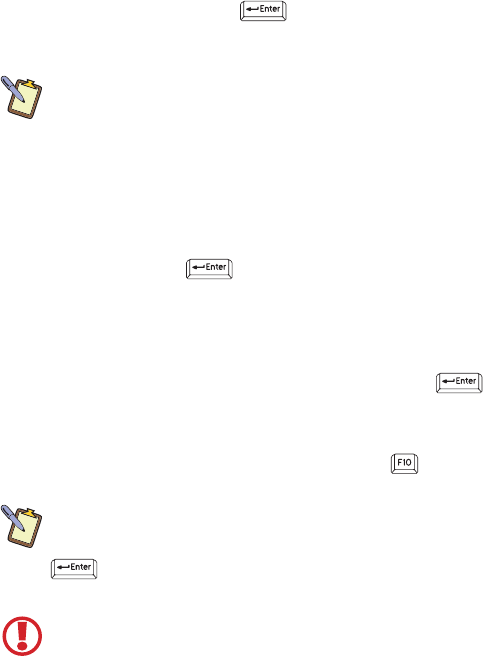
50 Chapter 05: Securing Your eo a7330
1. Power on or restart the eo a7330. As soon as the TabletKiosk
logo screen appears, tap on the screen with the stylus pen
(a7330D only) or hit the key on the keyboard to bring
up the SecureCore System Menu. From the menu, choose
“Launch System Setup” to enter the BIOS.
NOTE: Alternatively, you can also press the third function button on
the right side of the tablet when you see the TabletKiosk logo screen
to open the SecureCore menu.
2. When the BIOS Menu appears, tap on “Security” or press the
right arrow key on the keyboard to open to the menu screen.
3. If the TPM Support setting is set to “Disabled”, either tap on
it, or use the down arrow key to highlight the “TPM Support”
option and press to change it to “Enabled”.
4. Tap on “TPM State” at the top of the screen, or hit the right
arrow key on your keyboard to enter the menu screen.
5. If the Current TPM State reads “Disabled and Deactivated”,
tap on the “Change TPM State” option, or press , until it
changes to “Enable & Activate”.
6. Tap on the “Exit” menu item at the top of the screen and tap
on “Exit Saving Changes” or just press the key to save
changes to the BIOS and restart the computer.
NOTE: If at any point you wish to clear the TPM module’s information
and return the eo a7330 to its original “unowned” state, go back to the
“TPM State” menu and tap on the “Change TPM State” option or press
until it reads “Clear”. When you save changes and exit the BIOS
the TPM will be cleared.
VERY IMPORTANT: If you lose your password and decide to clear the
TPM, know that you will forever lose access to any data on the hard
drive that is encrypted using the TPM’s current encryption key. Make
sure that any data you wish to access in the future has been backed up
in an unencrypted form before clearing the TPM. Also, if you decide
to disable and deactivate the TPM, you will lose access to any data
currently encypted by the TPM until you reactivate it.
Creating a Windows Login Password
If you didn’t choose to do so during the initial setup procedure,
the first step in securing your sensitive information is creating a
Windows login password.
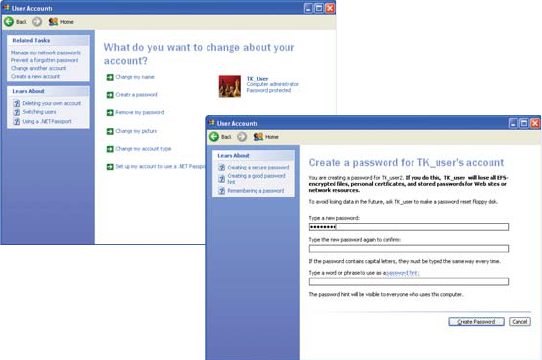
Chapter 05: Securing Your eo a7330 51
Creating the Password In Windows XP
1. Go to the START Menu and tap on “Control Panel”.
2. In the Control Panel window that appears, tap on “User
Accounts” under “Pick a category”.
3. Look under “or pick an account to change” and select your
user account by tapping on it.
4. Tap on “Create a password”. Enter a password and then
confirm it. Enter a password hint if you wish and then tap on
“Create Password” to accept your password.
Creating the Password In Windows Vista
1. Go to the START Menu and tap on “Control Panel”.
2. In the Control Panel window that appears, tap on the “User
Accounts” category title.
3. Under the User Accounts category, tap on “Change your
Windows password”.
4. From the “Make changes to your user account” screen, tap
on “Create a password for your account”.
Tap on “Create a Password”
to enter a new password.
This is an important step in
securing your data.
Make sure to keep your
password in a safe location
and do not lose it.
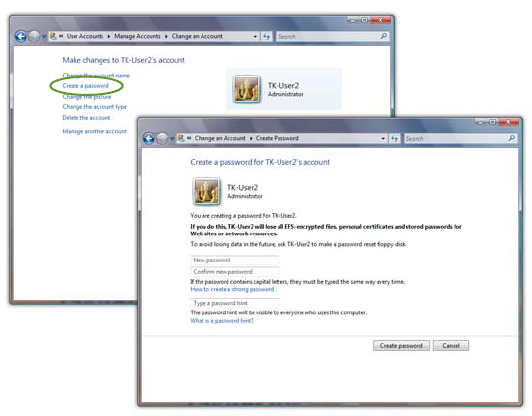
52 Chapter 05: Securing Your eo a7330
5. Tap on the text input field labeled “New Password” in the
window that opens and then enter a password of your
choice. Tap in the “Confirm new password” field and enter
it again exactly the same way. You may enter a hint in the
“Type a password hint” if you so choose.
6. Tap the “Create password” button when you are satisfied
with your password choice to commit the change.
It’s important when setting up a user account to manage the
security settings on the tablet that the user account be granted
administrator privileges. A standard user can still take advantage
of the protections provided by the TPM, just not mange it.
Contact your IT support staff for more information on user
privileges and how to assign them.
Setting Ownership of the TPM
After initializing the TPM functionality in the BIOS, the next step
to securing your eo a7330 is to establish yourself as the tablet’s
owner.
Make sure to keep
your password in
a safe location and
do not lose it.
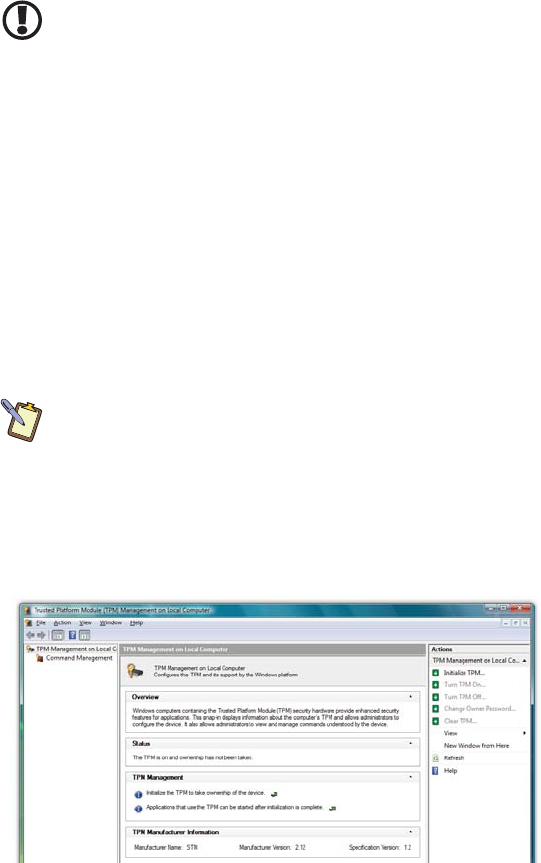
Chapter 05: Securing Your eo a7330 53
IMPORTANT: Once you have set ownership of the TPM, it is vital that
you store your password in a secure location and take care never to
lose it. If you do, you will not be able to access the data you protected/
encrypted using your security management software.
Windows XP Professional
As Windows XP lacks native support for TPM management, you
will need to acquire a third party TPM security management
application to take advantage of its capabilities.
Install and configure the TPM security management software
package of your choice and then refer to the user manual that
accompanied the software for information on how to accom-
plish this important task.
Windows Vista
To set ownership of the TPM:
NOTE: To perform the following procedure, you must be logged on to
your eo a7330 with administrator privileges.
1. Go to the START Menu and tap on “All Programs > Acces-
sories > Run” to open the “Run” dialog box.
2. In the “Open” field, enter “tpm.msc” (without the quotes)
and tap “OK” to open the TPM Management Console (TPM
MC). Tap to proceed if the Windows UA prompt appears.
The TPM Management Console is where you initialize the TPM to set
the ownership, turn on and off the TPM as well as clear the TPM.
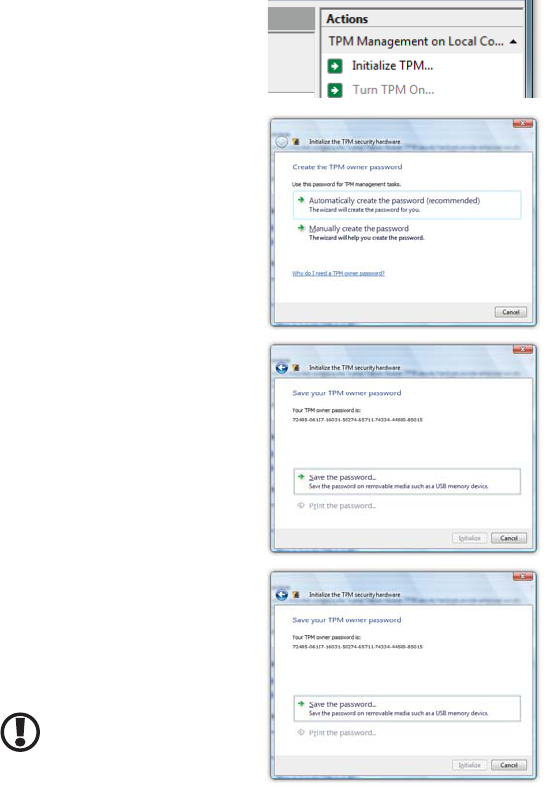
54 Chapter 05: Securing Your eo a7330
If you followed the steps in the BIOS Settings section earlier
in this chapter, the TPM MC should show the status of the
TPM as “on” but “not owned”. If the TMP MC shows that you
don’t have a compatible TPM or that it is not on, you either
skipped the steps above or didn’t successfully save the
settings in the BIOS.
3. In the “Actions” column
on the right side panel
of the TPM MC, tap on
“Initialize TPM...”.
4. On the “Create the
TPM owner password”
page, tap “Automati-
cally create the password
(recommended)” to have
Windows generate your
password automatically,
or “Manually create the
password” to input your
own.
5. After your password has
been created or entered,
tap “Save the password”
to save a .tpm password
file you can use to make
changes to the TPM
settings in the future.
6. In the “Save As” dialog
box, select a location
to save the password,
and then tap “Save”. The
password file is saved as
computer_name.tpm.
IMPORTANT: It is highly
recommend that you save
the TPM owner password to
removable media.
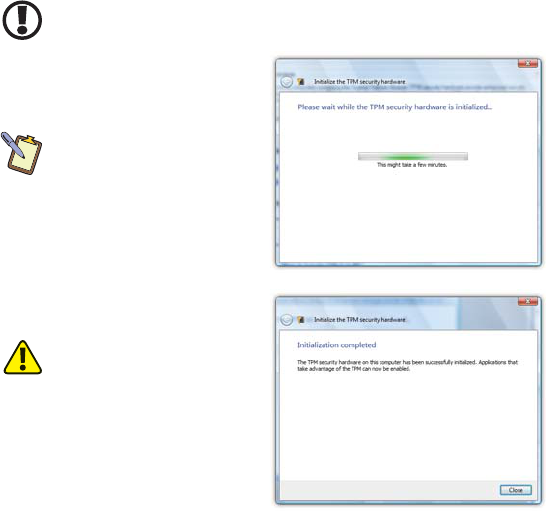
Chapter 05: Securing Your eo a7330 55
7. Click “Print the password” if you want to print a hard copy of
your password.
IMPORTANT: It is highly recommend that you print a hard copy of your
TPM owner password and store it in a safe location.
8. Click “Initialize” to
confirm and set the
ownership.
NOTE: The process of initial-
izing the TPM might take a
few minutes to complete,
so be patient. You will be
informed when the process
is complete.
9. Click “Close” to return
back to the TPM MC
main screen.
CAUTION: Do not lose your
password. If you do, you will
be unable to make changes
to your TPM that require
the owner password unless
you first clear the TPM. Once
cleared, all data protected
by the original password will
become unavailable.
To learn more about using the TPM, including turning off the
TPM and clearing the TPM, see the Help articles in the “Links &
Resources” section at the bottom of the main pane of the TPM
Management Console.


Chapter 06: Troubleshooting 57
This chapter describes how to locate information and solve some
of the problems you may encounter while using your eo a7330. If
after reading this section, you are still unable to solve a problem,
please check out more online resources at www.tabletkiosk.com/
support or contact the TabletKiosk Authorized Dealer where you
purchased your eo a7330 Tablet PC.
See the section later in this chapter entitled Contacting Your
Dealer for a list of the information you will need to supply in
order to receive the proper support.
Some common hardware problems, possible causes and sug-
gested solutions are presented in the following tables.
Audio Problems/Solutions
Problem Possible Cause Solution
There is no sound. The volume is either
muted or turned
down.
Use the Windows Volume control icon
in the System Tray (lower right corner
of the Task Bar near the clock) to ad-
just the volume and disable muting.
No sound is audible
through externally
attached speakers or
headphones
connected to the
Audio Out port on the
left side of the eo
a7330.
The speakers or the
headphones are
either connected
to the wrong jack
or are not securely
plugged in.
Make sure to check that the speakers’
or headphone’s audio plug is securely
connected to the Audio Out ( ) port
on the left side of the eo a7330.
External speakers are
not powered on.
Make sure the speakers are plugged
in and turned on.
Chapter 06
Troubleshooting

58 Chapter 06: Troubleshooting
Battery Problems/Solutions
Problem Possible Cause Solution
Beeping sound. The Tablet’s battery is
low and Hibernation
mode is disabled.
Connect the computer to an external
power source immediately.
The battery pack is
warm after charging.
This is a normal
condition.
No action is required.
The battery LED
indicator does not
light up whether the
battery is charging
or not.
No power is connect-
ed to the computer.
Check the power source and make sure
the AC adapter is securely plugged
into both the eo a7330 and the power
outlet.
The battery is above
10% charged.
Check the battery indicator icon in the
System Tray of the Windows’ Taskbar.
When not attached to a power source,
the LED indicator will only light up if
battery power is very low.
The battery pack is
nearing the end of
its life.
Replace the battery pack. Use only bat-
teries recommended for use with the eo
a7330 Ultra-Mobile PC.
Battery charge icon
is not accurately
displaying the
remaining charge.
Battery Pack requires
calibration.
Calibrate the battery pack as specified
in the chapter entitled Battery Care and
Usage.
The battery pack is
nearing the end of
its life.
Replace the battery pack. Use only bat-
teries recommended for use with the eo
a7330 Ultra-Mobile PC.
Battery pack will
not charge when
attached to power
source.
Power source voltage
exceeds battery
specifications.
The smart battery pack in your eo a7330
will shutdown and refuse to charge is
power amperage or voltage exceeds
its specifications. Check to make sure
the power source is within range of the
power specifications listed on the AC
adapter that came with your eo a7330
Ultra-Mobile PC.
Battery pack has
overheated.
Shutdown the eo a7330 and allow the
battery to cool down before restarting.
AC adapter is not
compatible with eo
a7330.
Check to make sure that the AC adapter
used to charge the batteries is the unit
that came with your eo a7330.

Chapter 06: Troubleshooting 59
Internet Problems/Solutions
Problem Possible Cause Solution
Unable to connect to
the Internet.
Account for Internet
Service Provider
(ISP) is not properly
configured.
Contact your ISP for assistance.
No valid network
connection detected.
Check the network status icon in the
System Tray to make sure you are con-
nected to a valid network. If not, rerun
the Network Set-Up Wizard or contact
your Network Administrator.
Wireless transmitter
is turned off.
Check the wireless power toggle on the
top of the eo a7330 to make sure it is
switched on.
Wireless security set-
tings are not correct.
Make sure that the wireless security
settings of your eo a7330 match the
settings of the wireless access point you
are trying to connect to, and that the
access Password (WPA), PIN (Protected
Set-up), or Key (WEP) is correct.
Networking Problems/Solutions
Problem Possible Cause Solution
Cannot see the
network.
Wireless transmitter
is turned off.
Check the wireless power toggle on the
top of the eo a7330 to make sure it is
switched on.
Cannot connect to
network.
Wireless security set-
tings are incorrect.
Make sure that the wireless security
settings of your eo a7330 match the
settings of the wireless access point you
are trying to connect to, and that the
access Password (WPA), PIN (Protected
Set-up), or Key (WEP) is correct.
The computer seems
to connect, but
doesn’t see any other
computers.
Correct workgroup
or domain name is
not set in computer’s
system properties.
Enter workgroup or domain name in
“Computer Name” tab of the System
Properties panel. Contact your network
administrator if you don’t know the
proper name to use.
Workgroup name is
correctly set in sys-
tem properties but
cannot connect to
any other computers
on the network.
Run the Network ID wizard in the “Com-
puter Name” tab of the System Proper-
ties panel and enter the correct network
type and Domain or workgroup name.

60 Chapter 06: Troubleshooting
Power Problems/Solutions
Problem Possible Cause Solution
The computer is
connected to an
external power
source but does not
turn on even though
the battery pack is
connected.
The battery pack may
be defective.
Replace the battery pack. Use only bat-
teries recommended for use with the eo
a7330 Ultra-Mobile PC.
The Power/Standby
light is off and the
system turns off
when it is left unat-
tended.
The system has gone
into Hibernation
mode.
Slide the Power toggle switch to the
right and hold for a second to resume.
The system will not
turn on after it turns
off when left unat-
tended.
The system has gone
into Hibernation
mode because it is in
a critical low-battery
condition.
Connect the eo a7330 to an external
power source.
USB Problems/Solutions
Problem Possible Cause Solution
An external device
does not work when
it is connected to one
of the USB ports.
The external device is
not receiving power.
Make sure that the external device is
plugged into an electrical outlet.
The external device is
defective.
Try connecting the external device to
another computer to determine if it
operates properly.
Windows is not rec-
ognizing the device
properly.
Disconnect the device, power it off, re-
connect the device and then turn it on.
Disconnect the device, power it off,
power it back on and then plug it back
into the computer.
Try the above two solutions, but plug
the device back in to the other USB
port.
Disconnect the device and power it off.
Shut off the eo a7330 normally. Power
on the device and plug it in. Power on
the eo a7330.

Chapter 06: Troubleshooting 61
Touch Screen Display Problems/Solutions
Problem Possible Cause Solution
The screen is blank. The system has gone
into Standby or
Hibernation mode.
Slide the Power toggle switch to the
right and hold for a second or two to
resume.
The mouse pointer
will not follow the
stylus pen properly.
The Digitizer requires
calibrating.
Run the calibration routine in the Pen
Tablet Properties Control Panel (see the
sectionDigitizer Set-up and Calibration
in the chapter Using Your eo a7330 with
Windows XP)
The mouse pointer is
not at the correction
position when your
finger touches the
screen.
The touch screen
requires calibrating.
Run the calibration routine in the Touch
Settings Control Panel (see the section
Touch Screen Set-up and Calibration in
the chapter Using Your eo a7330 with
Windows XP)
The mouse pointer
will not follow the
stylus pen properly
even after being cali-
brated.
Touch screen /
Digitizer controller
drivers are corrupted.
This can happen over time. Check the
TabletKiosk website to make sure you
have the newest available drivers, then
uninstall the current drivers and install
the new drivers.
The screen does
not rotate when the
screen rotation but-
ton is pressed.
The VGA display
driver is not set for
rotation support.
Use the Intel Media Accelerator Driver
control panel to enable the screen rota-
tion option in the “Display Settings” tab.
The VGA display driv-
ers are corrupted.
This can happen over time. Check the
TabletKiosk website to make sure you
have the newest available drivers, then
uninstall the current drivers and install
the new drivers.
The rotate screen
button has been
mapped to a dif-
ferent function by
a user.
Open the Launch Button applet in the
System Tray and check that the rotation
button is mapped correctly to the
rotation function. See the Using Your eo
a7330 with Windows XP for more infor-
mation on the Launch Button applet.
62 Chapter 06: Troubleshooting
Contacting Your Dealer
If you still have a problem, the next step is to contact the dealer
where you purchased your eo a7330.
Your dealer can determine if the problem will require that the
computer be taken to a service center for repair. Before you call
your dealer, please have the following information available:
1. Which model do you have?
2. What is the serial number?
3. How is your computer configured? What peripheral devices
are you using?
4. What messages, if any, appear on the screen?
5. What software were you running at the time of the problem?
6. What have you done already to try to solve the problem?
If you have overlooked a step, your dealer may be able to
solve the problem over the phone.

Chapter 06: Troubleshooting 63
Recovering Your System Using the System Restore DVD
Your eo a7330 should have come with a System Restore DVD that
matches the operating system that came pre-installed on your
Tablet PC. If your tablet didn’t come with a System Restore disc,
please contact the dealer where you purchased your eo a7330 to
request a disc.
NOTE: You will need to supply your system’s serial number, located on
the back of the eo a7330, with your request in order to receive your
replacement System Restore disc.
What you will need before you begin:
1. Included Windows® XP Professional, Windows XP Tablet PC
Edition, or Windows Vista® Business System Recovery DVD.
NOTE: It is important that you check to make sure that the disc you
received matches the Operating System (OS) that came pre-installed
on your eo a7330. If it is not, please contact the dealer where you
purchased your eo a7330 for a replacement.
2. External USB DVD drive with its own power supply (not USB
powered)
3. USB keyboard
4. USB mouse
5. USB hub or USB Expansion module
Recovering Your System with the Windows Vista® Business
System Restore Disc:
IMPORTANT: This process is destructive to the data stored on your
hard drive. All existing data will be lost. It is vital you back-up any files
you wish to keep before you proceed.
Step 1: Set up the required hardware:
Plug the USB keyboard, USB mouse and USB DVD drive into the
USB ports on the expansion module and main system. If you
don’t have the USB expansion module, plug the keyboard and
mouse and DVD drive into a USB hub and then plug the hub into
the USB port on the eo a7330. Make sure that the a7330 System
64 Chapter 06: Troubleshooting
Restore Disc is in the USB DVD drive and that the drive has power
and is on.
Step 2: Booting the eo a7330 to the Recovery Application on the
System Restore Disc:
1. Power up your eo a7330 Ultra-Mobile PC.
2. If your drive has an existing partition (overwriting existing
OS): When prompted, press any key to boot to the recovery
DVD.
If your drive doesn’t have an existing partition (new drive no
OS): It will automatically load the recovery application.
3. Select the “Tools” Button and then the “Reset Partition”
Button to continue.
4. Enter the partition size you wish to create for your OS. In
general, you should use the number from the “Free Space”
box as this will provide you with the largest system partition
possible.
5. Select the File System desired: FAT32 or NTFS. Click “Next”
to continue. (We recommend NTFS unless you require Windows
95/98/ME compatibility.)
6. Select “OK” to proceed with partition creation.
7. Select “OK” if you understand that this process will
PERMANENTLY DELETE ALL OF THE EXISTING DATA ON
THE HARD DRIVE.
8. Select “OK” once the drive has been partitioned and then
“Cancel” to return to the main menu.
9. Select the “Restore Now!” Button.
10. Select “OK” to prepare the partition you created above, and
then select “OK” again to restore the operating system.
11. Select “Quit” once the restore process completes to reboot
your eo a7330.

Chapter 06: Troubleshooting 65
12. Immediately eject the DVD or unplug the USB DVD drive
from your eo a7330 so the system will reboot from the
restored hard drive.
Recovering Your System with the Windows® XP Professional or
Tablet PC Edition System Restore Disc:
IMPORTANT: This process is destructive to the data stored on your
hard drive. All existing data will be lost. It is vital you back-up any files
you wish to keep before you proceed.
Step 1: Set up the required hardware:
Plug the USB keyboard and USB mouse into the USB hub and
plug the hub into one of the available USB ports on the tablet.
Plug the USB cable from the DVD drive into the remaining USB
port of the tablet. Make sure that the a230T System Restore Disc
is in the USB DVD drive and that the drive has power and is on.
Step 2: Partitioning the Hard Drive (required for a new Hard
Drive only):
If you are simply attempting to restore your eo a7330 using the hard
drive that came with your system, you can skip this step and proceed
to Step 3.
You will need to use the software that came with your new hard
drive—or another third party program of your choosing that is
designed to partition hard drives—in order to create a primary
system partition to house the restored OS.
NOTE: At a minimum, any bootable disc containing Microsoft’s
“FDISK.EXE” utility should be sufficient. If you attempt to start the
restore utility before successfully partitioning the drive, the Windows
installer will crash with a B.S.O.D. displaying a “STOP: 0x07” error.
Step 3: Booting the eo a7330 to the Recovery Application:
1. Power up your eo a7330 Tablet PC.
2. It will start from the DVD and automatically load the recov-
ery application.
3. Select “OK” to proceed with partition creation.

66 Chapter 06: Troubleshooting
4. Select “OK” if you understand that this process will
PERMANENTLY DELETE ALL OF THE EXISTING DATA ON
THE HARD DRIVE.
5. Select “Quit” once the restore process completes to reboot
your eo a7330.
6. Immediately eject the DVD or unplug the USB DVD drive
from your eo a7330 so the system will reboot from the
restored hard drive.
NOTE: If you do not, or cannot, remove the external drive from your
tablet, make sure to go back into the BIOS upon restart to change the
“1st BOOT” option back to the internal hard drive.
What to do After You Have Restored Your System
When your eo a7330 first boots up after a successful system
restoration, it will behave exactly as it did the very first time you
turned it on. You will need to finish the Windows localization
procedure, customize the installation (including the networking
settings) and then reinstall of your applications.
Before reinstalling your applications, we recommend that you
check the Downloads section of the TabletKiosk website for any
drivers or applications that might have been updated after the
installation disc was created.
Lastly, make sure to check the Windows Update site for any new
Important or Critical patches.
Chapter 06: Troubleshooting 67
This Page Left Blank Intentionally


Chapter 07: Specifications 69
Processor
Intel® Atom™ Z530P (1.60 GHz)
45nm Hi-K metal gate silicon technology (2.2W max TDP)
On-die, primary 32-KB instructions cache and 24-KB write-
back data cache
133 MHz Source Synchronous Front Side Bus (FSB)
On-die 512-KB, 8-way L2 cache
Support for IA 32-bit architecture
Intel® Streaming SIMD Extensions-2 and -3 (Intel® SSE2 and
Intel® SSE3) support and Supplemental Streaming SIMD
Extension 3 (SSSE3) support
Intel® Hyper Threading Technology (2-threads)
Intel® Enhanced SpeedStep® Technology
Intel® Virtualization Technology (Intel® VT)
Execute Disable Bit support for enhanced security
Supports C0/C1(e)/C2(e)/C4(e) power states
Intel Deep Power Down Technology (C6)
L2 Dynamic cache sizing
Chipset
Intel® System Controller Hub (SCH) US15WP
Integrated single chip graphics, memory and I/O controller
Chapter 07
Specifications
70 Chapter 07: Specifications
Low power thermal design consumes less than 2.3W
Integrated DDR2 memory controller with 64-bit wide
interface and maximum configuration of 2.0 GB DRAM
Integrated USB Host Controller supports USB 1.1 and 2.0.
Power Management
ACPI 1.0b and 2.0 compliant
ACPI S0, S3, S4, S5
CPU states C0, C1, C2, C3, C4, C6 states
PCI Express Link states: L0, L0s, L1, L2, L3
Rapid Power Management
Memory
1x DDR2 533/400 MHz SODIMM slot (up to 2.0 GB)
Single 64-bit wide channel
2.0 GB standard on a7330D, 1.0 GB standard on a7330T
Battery
2x Modular battery bays
38W Lithium-Ion 4-cell (2S2P) Smart IC Main battery pro-
vides 4 ~ 5 hours of power
23.5W Lithium-Polymer 2-cell (2S1P) Smart IC battery for 7
hours of total power (standard with a7330D, optional with
a7330T)
Over Charge Protection, Over Discharge Protection, Over
Current and Output Short Protection, Over Thermal Protection
Hard Drive
1.8” format, 8mm/5mm height, configurations from 80GB
Ultra DMA 100 PATA I/F (Bus transfers up to 100 MB/sec.)
Automatic retry/error correction for high data integrity
Chapter 07: Specifications 71
Shock resistant — operating: 4,900 m/s2 (500G)
non-operating: 14,700 m/s2 (1,500G)
Quiet — 14dB idle, 20dB random track seek
300,000 hours MTTF (Mean Time to Failure) possible.
Video
Intel® GMA 500 provides integrated 2D and 3D graphics
MPEG-2/MPEG-4/H.264/VC-1/WMV-9 HD video decoder
DirectX 9.1 compatible
Two pipe scalable unified shader implementation (Fill rate: 2
pixels per clock, Vertex rate: one triangle 15 clocks)
Windows® Aero (Glass) Technology capable
Screen rotates 0°, 90°
1024 x 600 Landscape, 600 x 1024 Portrait
Dual display support
External Display up to UXGA (1600x1200) with CRT Hot Plug
support (when paired with optional Docking Cradle)
Display
Toshiba LTD121KCAV 12.1” TFT XGA LCD Wide Angle Display
TransTouch Technology Passive Resistive Touch Screen
PenMount 6000 USB Controller Chipset (PM6300)
160 points per second sample rate
1024 x 1024 resolution
Audio
Intel® High Definition Audio Interface
Realtek ALC269 HD Audio Codec
98dB Signal-to-Noise Ratio (A-weighting) for both DAC
output and ADC input
72 Chapter 07: Specifications
2+2 channel 16/20/24-bit / 44.1KHz/48KHz/96KHz/192KHz
sampling rate output (DAC)
4 channel 16/20/24-bit / 44.1KHz/48KHz/96KHz sampling
rate input (ADC)
EAX™ 1.0 & 2.0, DirectSound 3D™, A3D™, and I3DL2 compatible
HRTF 3D Positional Audio in Windows XP
Built-in Stereo Speakers and Dual Digital Microphone Array
for added fidelity and accuracy
3.5 mm Headphone & Microphone Plug ‘n Play Jacks
WiFi Wireless
Intel® WiFi Link 5100 PCIe Half Mini Card with Power ON/OFF
Switch
MIMO (Multiple Input, Multiple Output) support 802.11n
with 1x2 MIMO
Dual-Band/Quad-Mode support (IEEE 802.11a/b/g/n),
compatible with IEEE 802.11d /e (Quality of Service [QoS]),
802.11h, and European Telecommunication Standards
Institute [ETSI] specifications), and IEEE 802.11i (pre-authen-
tication)
Reduced power consumption in idle associated (25mW)
EIT v4.0 support
Automatic switching between the two bands (2.4 GHz and
5.0 GHz)
Uses the 5.170 to 5.825-GHz Industrial, Scientific, and
Medical (ISM) frequency band as defined by the IEEE 802.11a
specification
Uses the 2.412- to 2.497-GHz ISM frequency band defined by
the IEEE 802.11b/g specifications
Can operate on a 40MHz wide channel
Provides 128- and 64-bit WEP encryption, hardware AES
(support for key sizes of 128 bits, 192 bits, and 256 bits)
Chapter 07: Specifications 73
Hardware capability to support Cisco* Compatible Exten-
sions v1/2/3/4
Supports IEEE 802.11 Power Save Protocol (PSP)
Supports Basic Service Set (BSS) (AP) and Independent Basic
Service Set (IBSS) (peer-to-peer) modes (in legacy 802.11b/g
only)
Supports Intel® Wireless Coexistence System (WCS) Phase II
for Bluetooth® devices
Supports WiFi-WiMAX coordination
Wake on WLAN (WoWLAN) support
Bluetooth® Wireless
CastleNet BTC04R200(T) Bluetooth® 2.1+EDR built-in USB
module with Power ON/OFF Switch
GPS Module
Ublox UBX-G5010 built-in USB module
50-channel u-blox engine with more than one million
effective correlators
<1 second Time To First Fix for Hot Aided Starts
SuperSense® Indoor GPS providing best-in-class acquisition
and tracking sensitivity
Accelerated start-up at weak signals with KickStart feature
Supports AssistNow Online and AssistNow Offline A-GPS
services; OMA SUPL compliant
Hybrid GPS (L1 freq., C/A code), GALILEO (Open Service L1
freq.) and SBAS (WAAS, EGNOS, MSAS, GAGAN) engine
4 Hz position update rate, operational up to 515 m/s (1,000 knots)
RoHS compliant and green
74 Chapter 07: Specifications
Gigabit Ethernet Embedded LAN Controller
Realtek RTL8111C-GR PCI Express 1.1
Integrated 10/100/1000 transceiver
Supports pair swap/polarity/skew correction
Crossover Detection and Auto-Correction
Wake-on-LAN and remote wake-up
Microsoft® NDIS5, NDIS6 Checksum Offload (IPv4, IPv6, TCP, UDP)
and Segmentation Task-Offload (Large send and Giant send)
Full Duplex flow control (IEEE 802.3x)
IEEE 802.3, IEEE 802.3u, IEEE 802.3ab compliant
IEEE 802.1P Layer 2 Priority Encoding
IEEE 802.1Q VLAN tagging
Supports power down / link down power saving
TPM Security
Infineon Single-Chip SLB 9635 TT 1.2 Trusted Platform
Module (TPM)
Trusted Group Computing (TCG) v1.1B / v1.2 compliant
Security architecture based on Infineon security controller
family
ROM for TCG firmware
EEPROM for TCG firmware and data
Hardware hash accelerator for SHA-1 algorithm
Advanced Crypto Engine (ACE) for asymmetric key opera-
tions (up to 2048-bit key length)
Power saving sleep mode
I/O Ports
1x 4-pin USB 2.0 (additional 2x USB with USB Module that
comes standard on a7330D, optional for a7330T)
Chapter 07: Specifications 75
10/100/1000 Ethernet (RJ45)
1x DC-In
1x 3.5mm Audio Out, 1x 3.5mm Audio In
1x Cradle Connector
(Optional Docking Cradle adds 3x USB 2.0 ports,
1x RS-232 serial port, 1x 15-pin D-Sub connector (VGA),
1x RJ45 jack for 10/100 Mbps Ethernet LAN,
1x DC-In with power pass-thru, main and secondary battery
charging slots)
Weight
.99 kg (2.18 lbs.) with main battery pack
1.16 kg (2.56 lbs) with main and secondary battery packs
Measurements
213 mm x 140 mm x 29.5 mm (8.4 in x 5.5 in x 1.16 in)
Case Color
Black
LED Indicators
Power (ON: blue, Standby: blinking)
Battery (Charging: orange, Low (<10%): orange blinking,
Fully charged with DC connected: green)
Hard Drive (Activity: blue blinking)
Wireless Networking (WiFi ON: blue), Bluetooth® (ON: blue)
Function Buttons (Right Side)
SAS (Ctrl+Alt+Del)
Screen Rotation
User Programmable
User Programmable
76 Chapter 07: Specifications
Control Switches (Top)
System Power Switch
Bluetooth® Transmitter On/Off
Wireless Networking Transmitter On/Off
AC Adapter
Input voltage (nominal): 100 ~ 240 Vac
Input voltage (maximum): 90 ~ 265 Vac
Input Frequency: 47 ~ 63Hz
Input current: 2.4A maximum at 90 Vac
Output voltage: 11.4V ~ 12.6V DC
Output current: 4.16A maximum
Output Power: 50W
Ripple & Noise Maximum: 380 mVp-p
SCP: Short Circuit Protection plus Auto-Recovery ≤ 2 min.
OVP: Over-Voltage Protection, Latch Mode, up to 18.0Vdc
maximum
OCP: Over-Current Protection, Auto-Recovery, up to 10.0A
maximum
OTP: Over-Temperature Protection to prevent catastrophic
failure from overheating.
Operating Environment
Temperature: +5°C ~ +35°C (+41°F ~ +95°F)
Humidity: 20% ~ 80% (without condensation)
Storage Environment
Temperature: -20°C ~ +65°C (4°F ~ 149°F)
Humidity: 20% ~ 80% (without condensation)
Chapter 07: Specifications 77
This Page Left Blank Intentionally

310 782 1201 tel
310 782 1205 fax
www.tabletkiosk.com
UG.a7330.rev.07.03.09
